This page contains affiliate links. Please read our disclosure for more info.
Kyoto in autumn is gorgeous. The ancient Japanese city abounds with temples and gardens full of maple trees that turn from green to gold, then orange and fiery red.
We found koyo (fall foliage season) just as beautiful as cherry blossom season, and it lasts longer.
In this post, I share our picks for the best places to see autumn foliage in Kyoto, from famous temples to quiet gardens.
Plus, you’ll learn when to expect fall colours and how to find out which temples have peak colour during your visit. There’s a map at the end with all these top spots.
Contents
- Best Time to Visit Kyoto for Autumn Foliage
- Kyoto Autumn Leaves Forecast 2024
- Best Kyoto Fall Foliage Spots
- Autumn Temple Illuminations
- Where to Stay in Kyoto in Autumn
- Weather in Kyoto in Autumn
- Map of Kyoto Autumn Foliage Spots
- Is Kyoto in Autumn Worth It?
- More Japan Posts
Best Time to Visit Kyoto for Autumn Foliage
November is the best month to visit Kyoto to see autumn foliage. Colour usually starts around the middle of the month and peaks towards the end of November.
Peak foliage dates vary yearly (see the forecasts below), but the last week of November is the safest bet.
If possible, I would avoid Labor Thanksgiving Day on 23 November, as it’s a very busy day for leaf viewing.
We were lucky to spend a month in Kyoto in 2023 and could see autumn colour for over two weeks from 22 November to 7 December (when we left).
It was greener towards the beginning of that period and past peak by the end. The colours were at their best from 24 to 30 November.
If you visit earlier in November, you can still find fall colour at higher elevations using the forecast tools below.
If you visit Japan in late September or October, you will have to find autumn foliage outside of Kyoto, such as in far north Japan (Hokkaido) or at higher elevations.
Kyoto Autumn Leaves Forecast 2024
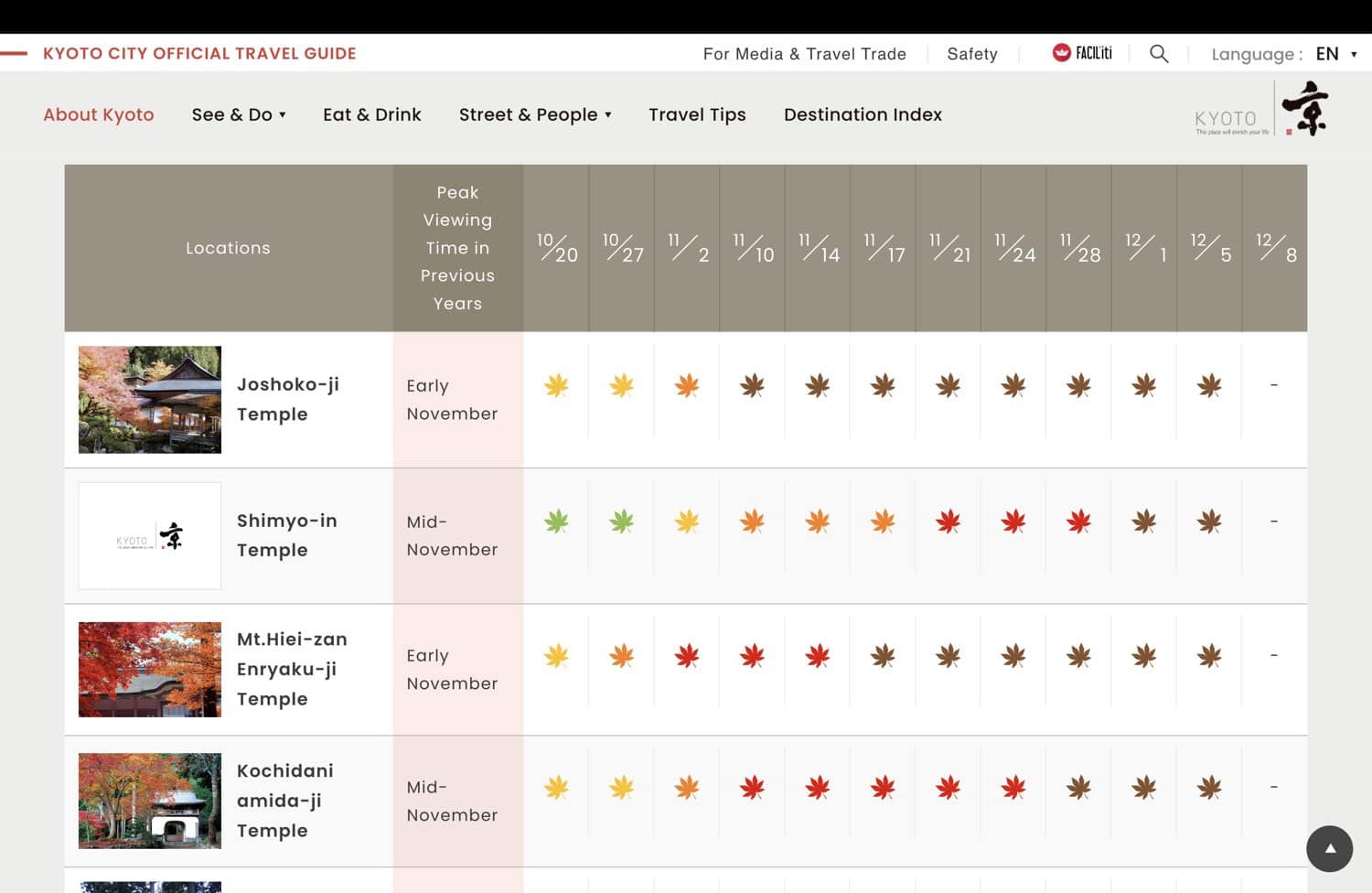
The Kyoto autumn leaves forecast for 2024 is currently predicting that the best time to see autumn colour is later than average.
It predicts the peak time to be 16 December 2024 for Kyoto (11 days later than average). Note that there was a similar prediction on our 2023 visit, but the peak ended up being at the end of November.
As of 22 November 2024, some spots in Kyoto have just started to hit peak colours.
We used these fall foliage forecast sites to plan our autumn sightseeing.
Before You Arrive
Japan Meteorological Corporation is a good first stop to get a sense if fall colours are expected in Kyoto (and elsewhere in the country) earlier or later than usual. The first forecast is released in early September but subsequent forecasts will be more accurate.
They have two projections for ginkgo (golden leaves) and momiji (red Japanese maple leaves). It’s momiji that you want to focus on for Kyoto, although you will find a few gingko trees lining the streets.
If summer is longer and hotter than usual, fall foliage will peak later than usual.
In Kyoto
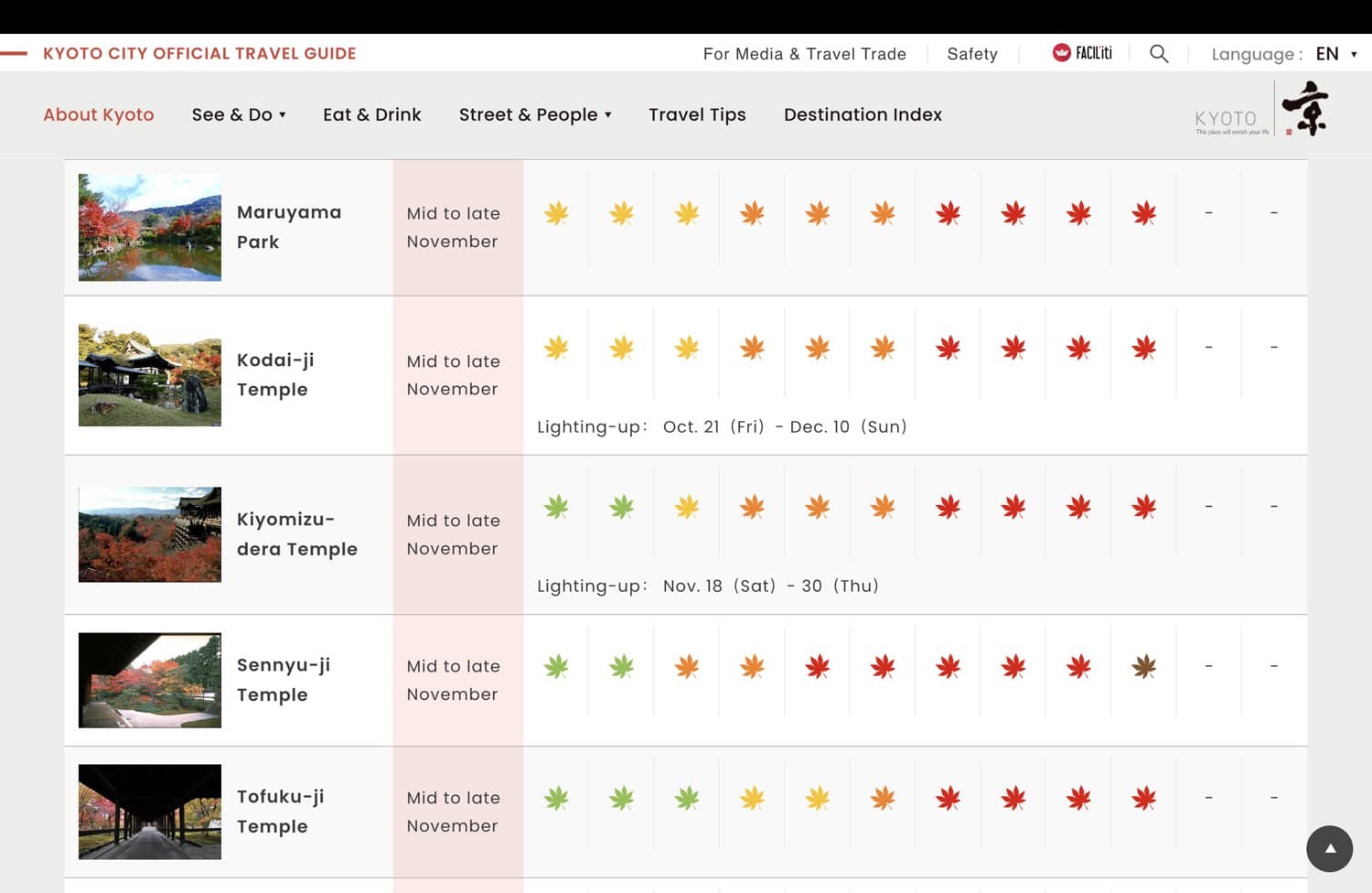
Once you are in Kyoto, we found the Kyoto City Autumn Leaves Calendar the most useful tool to plan where to go and when.
It lists many temples, gardens, and parks across the city and its outskirts. At the top, you’ll find dates from 25 October to 10 December (it’s updated twice a week during this time), with symbols marking when each spot is at its peak.
Red leaves represent peak colour, and although this is the best time to go, it’s still worth visiting when it’s orange (partially coloured) or brown (past peak).
The calendar also notes if reservations are needed and if the temple has a night illumination.
Another helpful tool is Souda Kyoto, which has frequently updated photos of many temples so you can see how the colours are progressing. You’ll need to translate the page from Japanese.
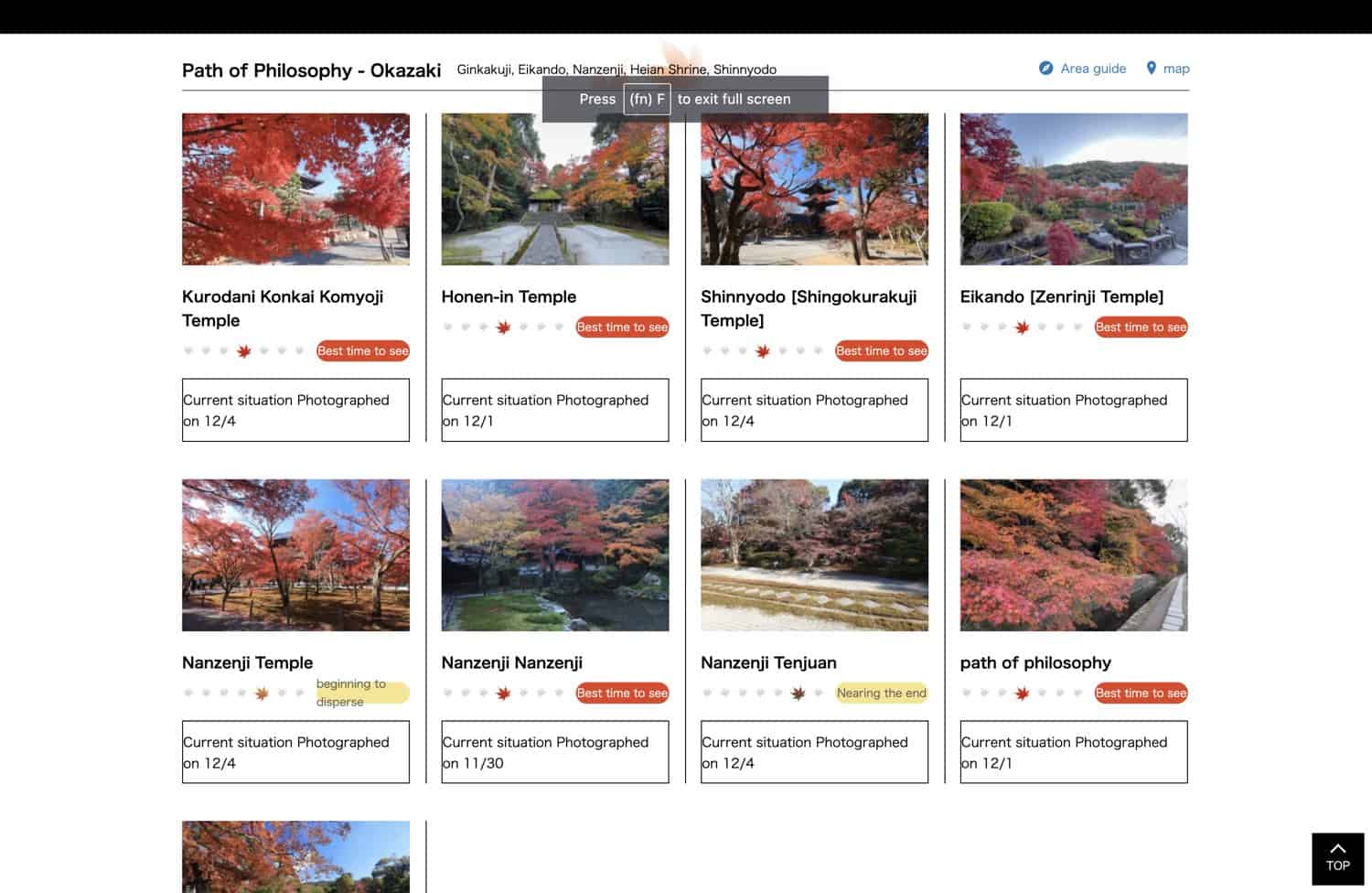
Finally, the Kishou website (which also requires translating) has peak estimates for each temple and a popularity score (the most popular spots have three stars).
Best Kyoto Fall Foliage Spots
The best places to see the colourful autumn leaves in Kyoto are at temples. You’ll find the odd vibrant red or yellow tree while wandering the city, but the temples (plus gardens and parks) are where you’ll see masses of colour.
These are our favourite Kyoto fall foliage spots (roughly ranked), but you can see some lovely colour at almost all temples.
In addition to these, we enjoyed visiting Kodaiji, Entokuin, and Shorein (all in Southern Higashiyama). While the colourful trees aren’t as extensive, they aren’t as busy as more well-known koyo spots.
See our posts on the best things to do in Kyoto and Kyoto temples for details on these and more ideas.
Note that most temples are open from 9am – 5pm (last entry 4pm) with an entrance fee of around 500 – 600 yen / $3.50 – $4 (many are cash only). A few temples charge extra at this peak time.
1) Eikando
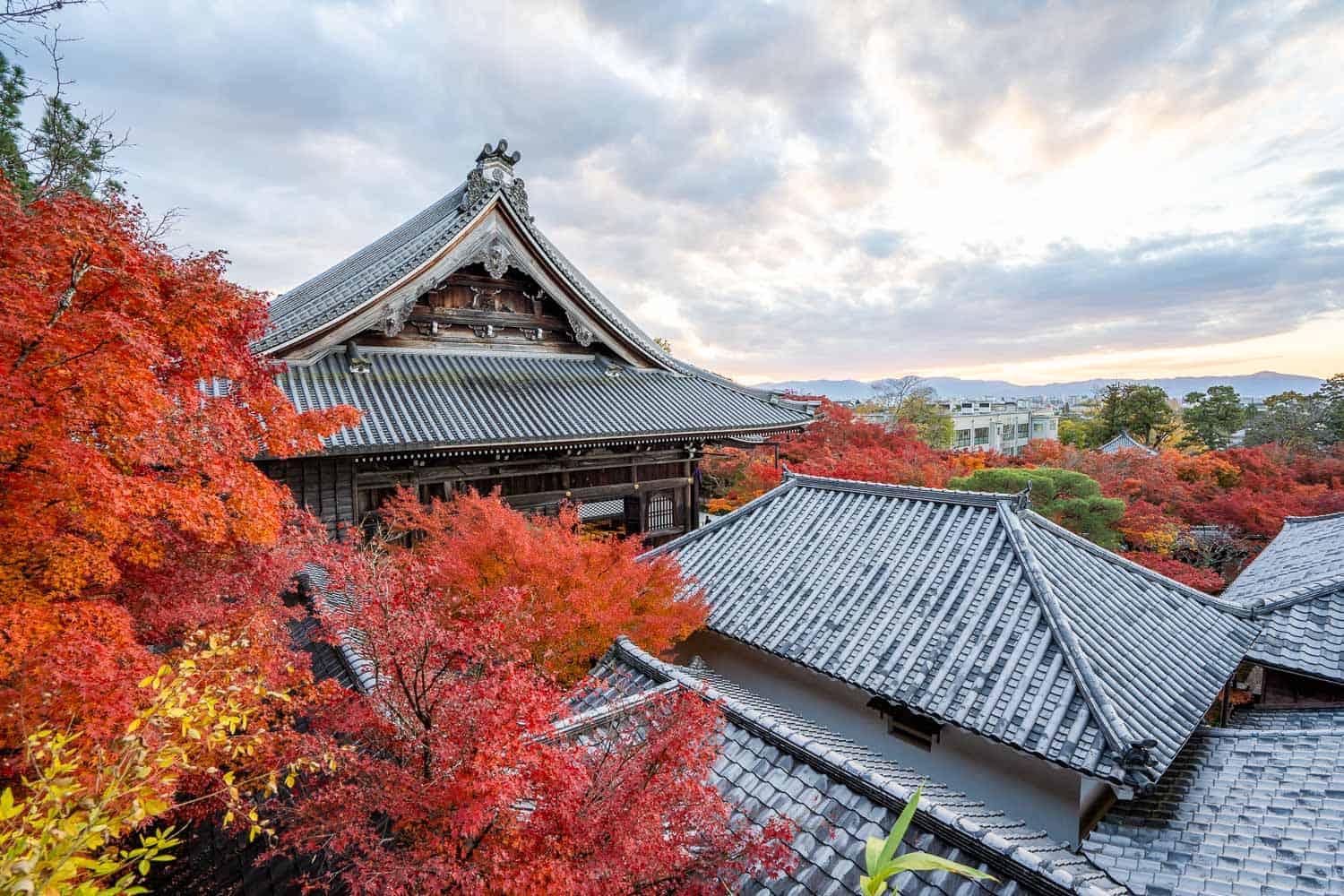
Eikando is my top pick for seeing autumn foliage in Kyoto. This temple is located north of Nanzenji, near the Philosopher’s Path.
While it isn’t well known amongst foreigners, it’s a popular autumn spot for Japanese visitors.
It’s worth braving the crowds as the maples are extensive and colourful, and the scenery is diverse, with a pond, several temple buildings, and a city view from the hillside.
We arrived in the late afternoon (3.45pm) on a weekday in an attempt to avoid the crowds. It was still jam-packed but eased off by 4.30pm.
There’s lots to see in this large complex, and we spent 1 hour and 10 minutes there. You start inside and follow a set route along the wooden corridors without shoes (wear warm socks). Bring a bag to carry your shoes if you can (but they do provide plastic bags).
In this indoor section, you walk in a stream of people and can admire ancient fusuma (decorated sliding doors) and the courtyard garden with maples and a small pond.
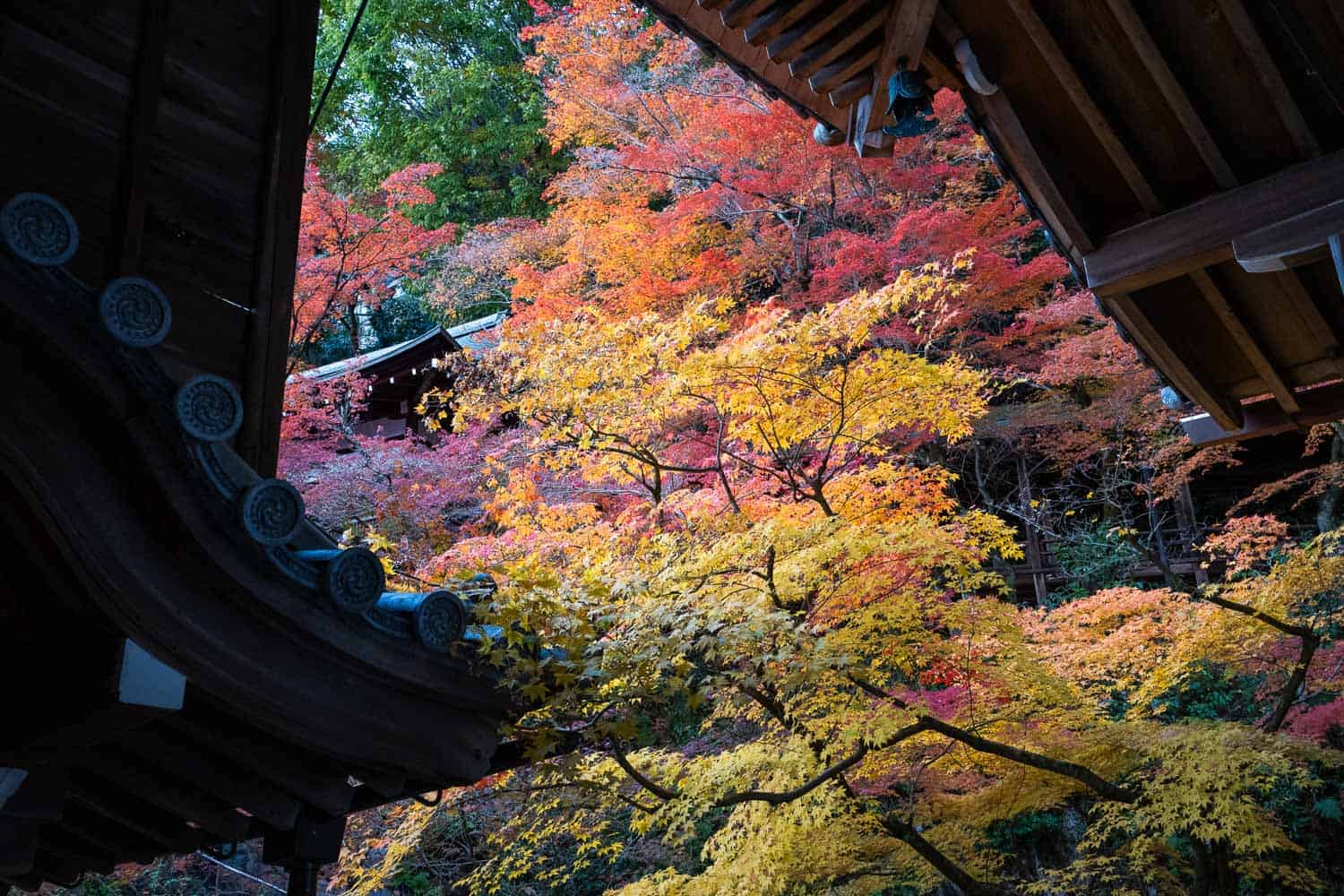
You gradually make your way to a temple building higher on the hill with different views of dense clusters of maples on the way.
Then put your shoes back on to explore the exterior. Walking up the hill to Tahoto Pagoda is a highlight for a view of Kyoto and a sea of red and orange.
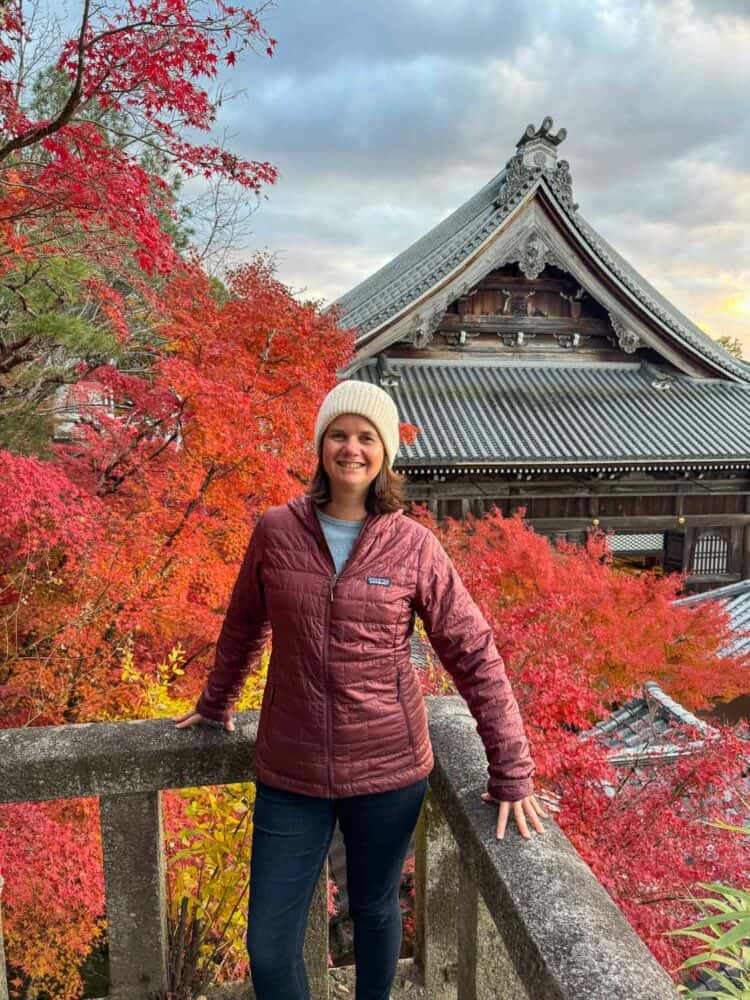
Back down the hill, the Hojo Pond is stunning, with vibrant colours, a scenic bridge, reflections of the trees in the water, and a view of the pagoda on the hillside. We even had a full moon to add to the magic.
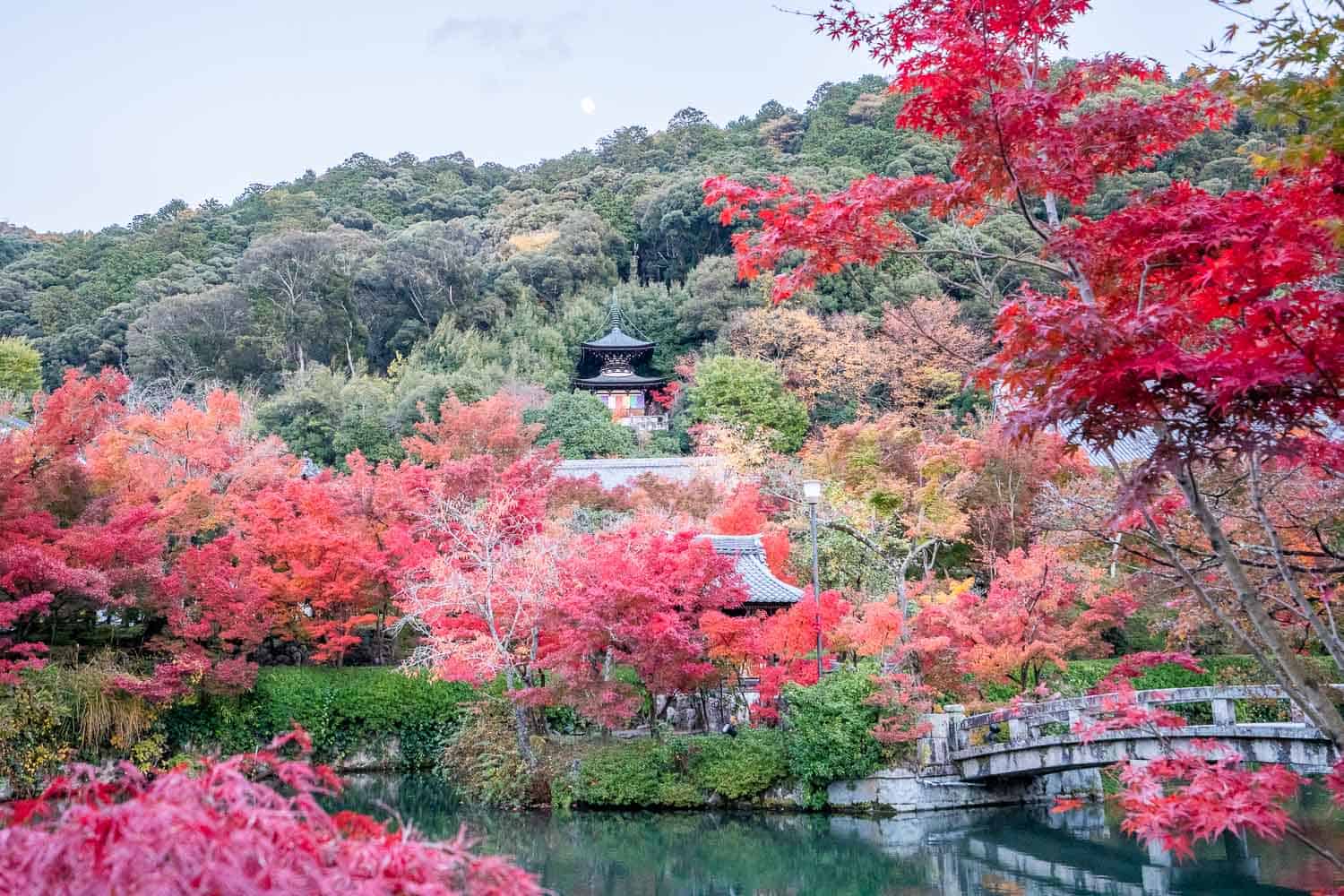
There’s a teahouse by the pond, but it was closed when we arrived just before 5pm closing.
Eikando also has one of Kyoto’s best night illuminations in autumn. I recommend visiting by day and night as they are different experiences (and you don’t see the inside areas or hillside pagoda at night).
2) Enkoji
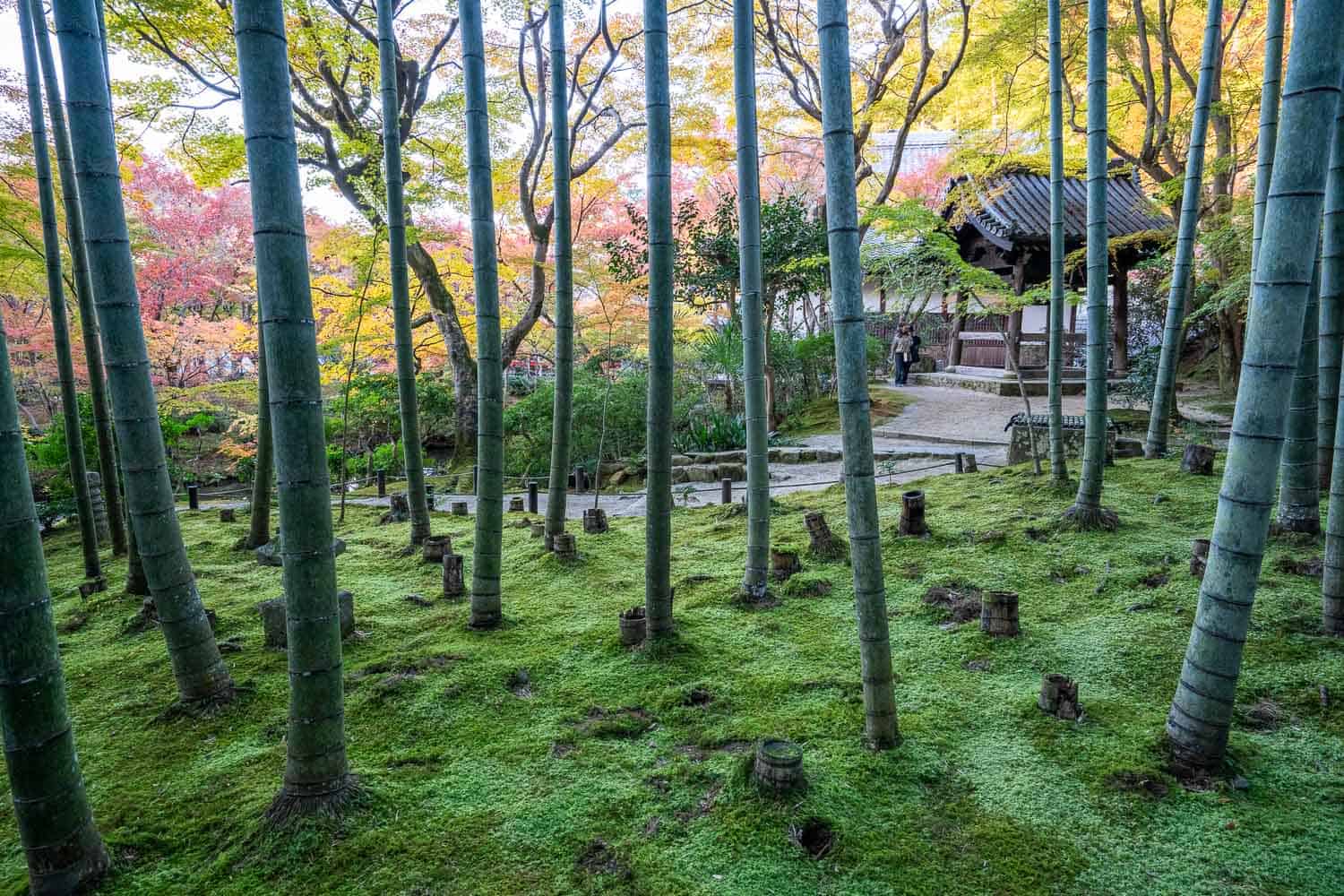
Enkoji is a little out of the way in Northern Kyoto, but it’s worth visiting in the autumn for its diversity, city view, and lower crowds than many other temples.
Reservations on the Enkoji website are required in autumn (and the price is higher than the rest of the year at 1000 yen/ $7), but we got a booking a day in advance. We booked the 4pm last slot to see the sunset.
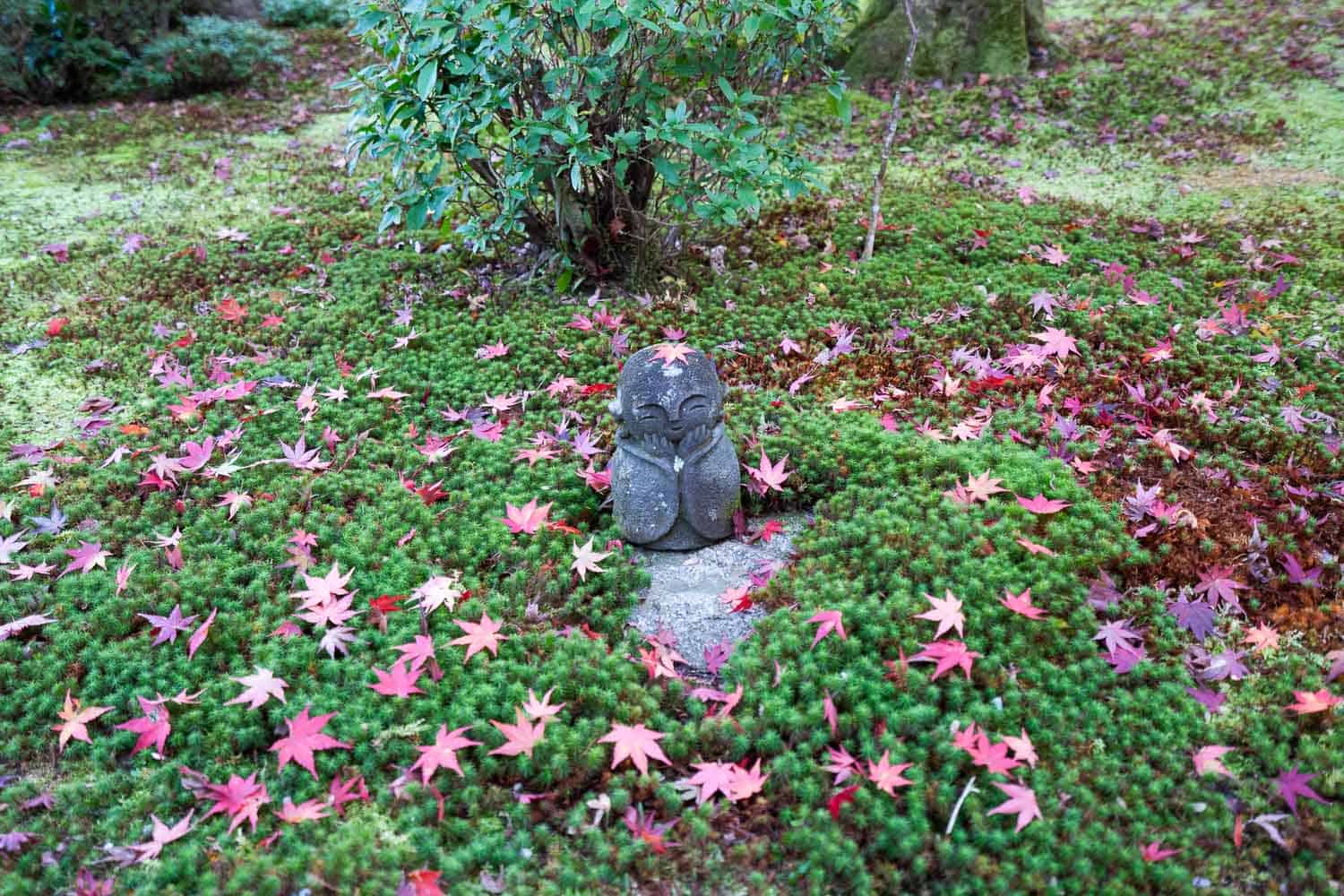
Enkoji is smaller than Eikando but still varied with a karesansui Zen garden (rock garden), beautiful fusuma, mossy gardens, small bamboo grove, and pond with maple reflections.
Our favourite part was the tatami room where you can sit peacefully and admire the gardens. You don’t get this time for contemplation at the busier temples.
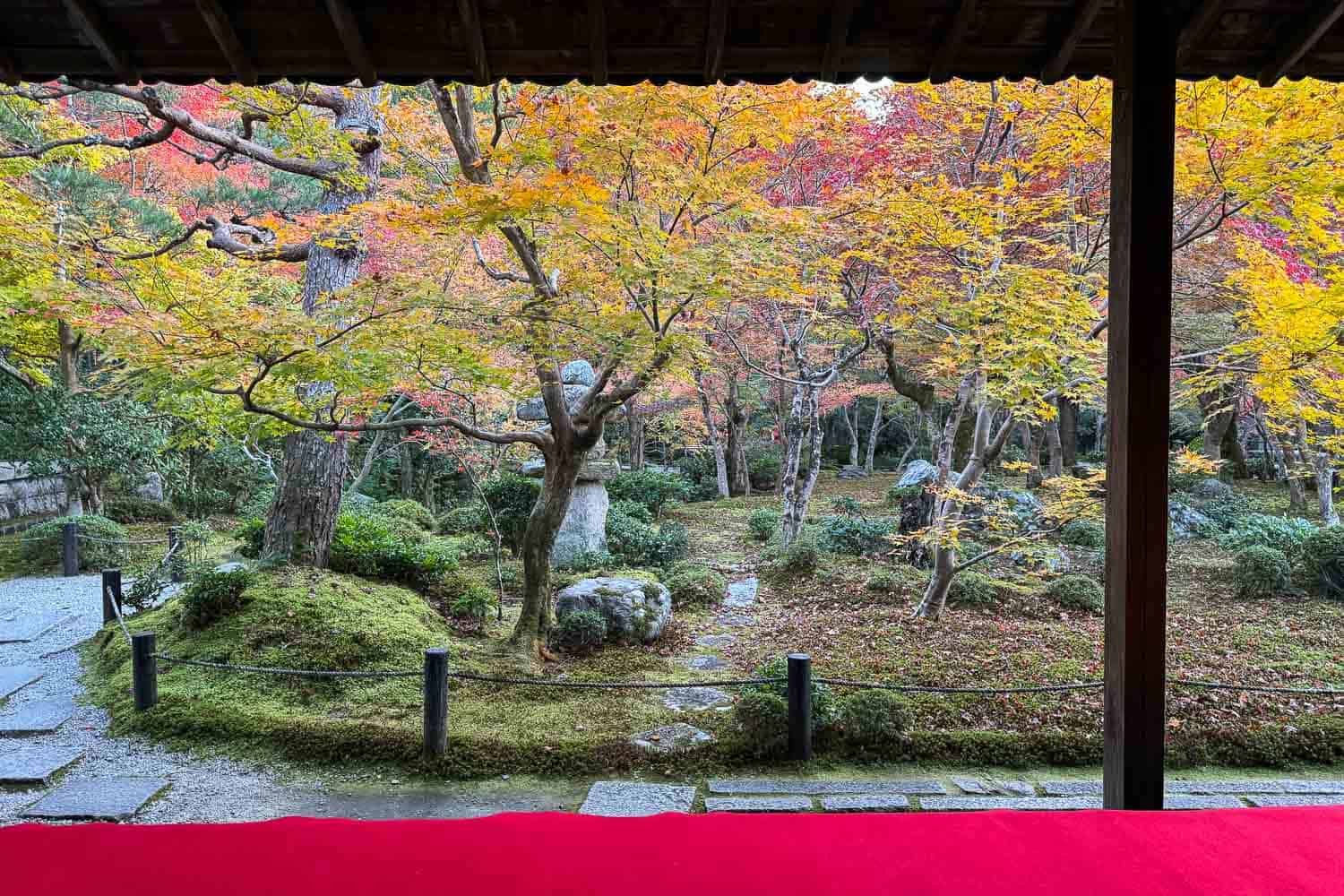
Afterwards, we walked up the hill to get a good view of the city and sunset. While it doesn’t have the same sea of maples as Eikando, it was a more peaceful experience.
Also Worth Visiting: Shisendo Temple is only a few minutes from Enkoji and is another quieter spot. It’s not known for its autumn colour, but there are some lovely colourful trees and a tatami room to admire them from. We visited for 30 minutes before Enkoji.
3) Jojakkoji
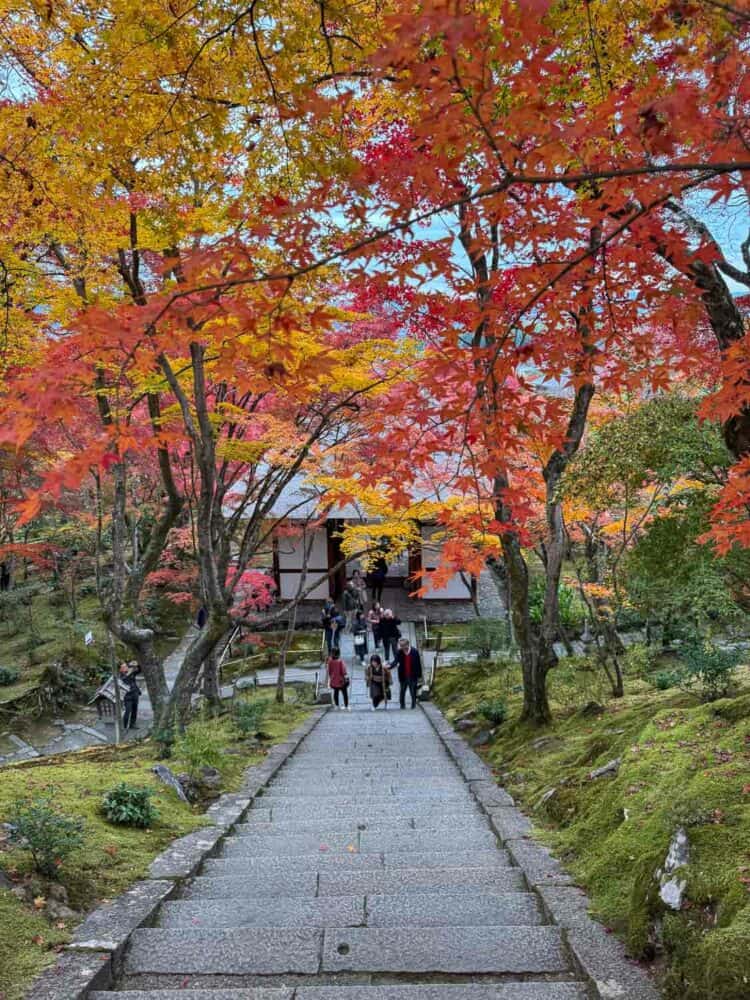
Jojakkoji is one of our favourite cherry blossom spots in Kyoto and is even more stunning in autumn—but a lot busier.
It’s located in Arashiyama, a distant neighbourhood that’s a must-visit in autumn (more recommendations below).
At any time of year, I love Jojakkoji’s hillside location, thatched roof gate, mossy gardens, bamboo grove, and pagoda.
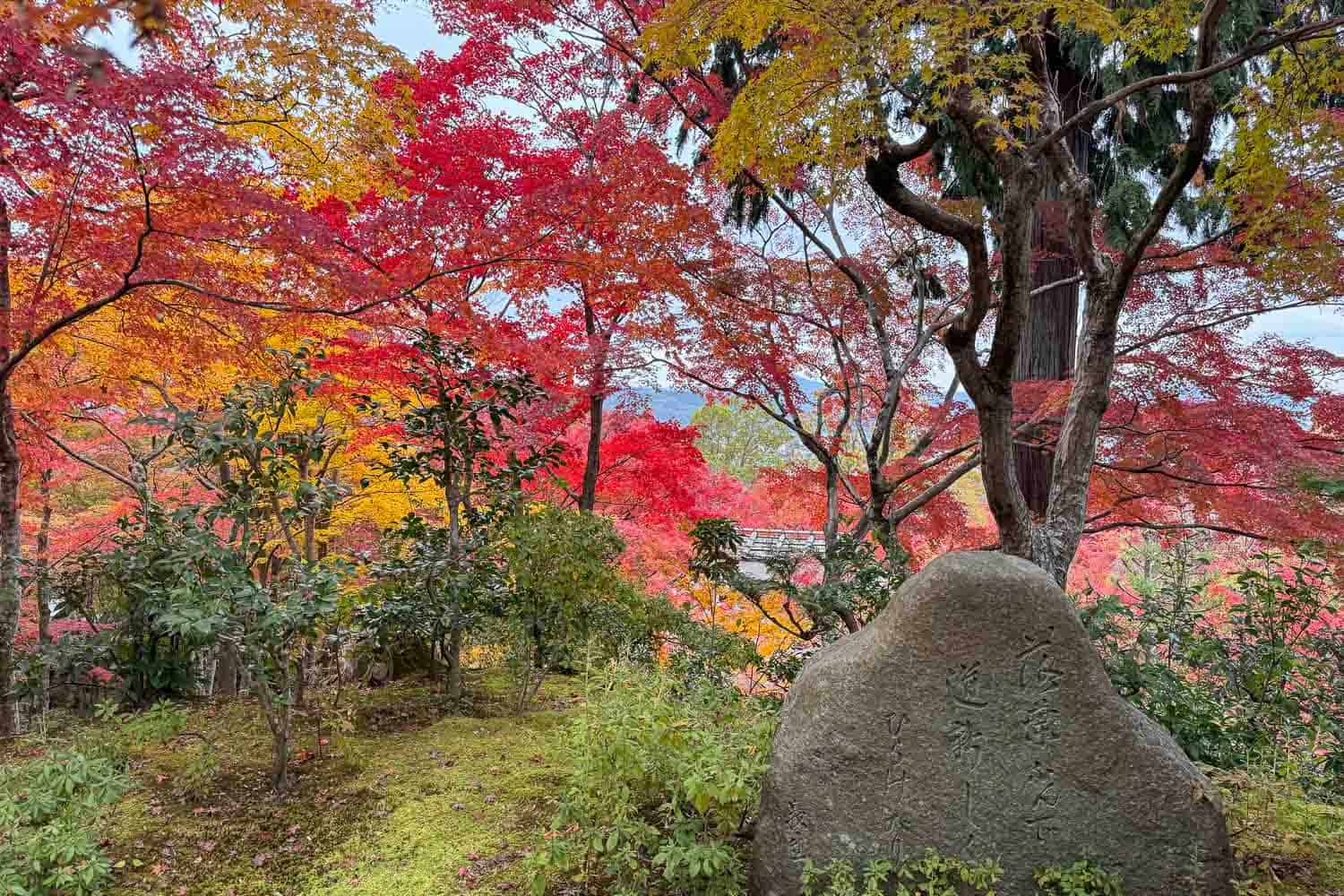
Add to that vibrant red, orange, and yellow maples, and it’s a stunning spot.
4) Kiyomizu-Dera
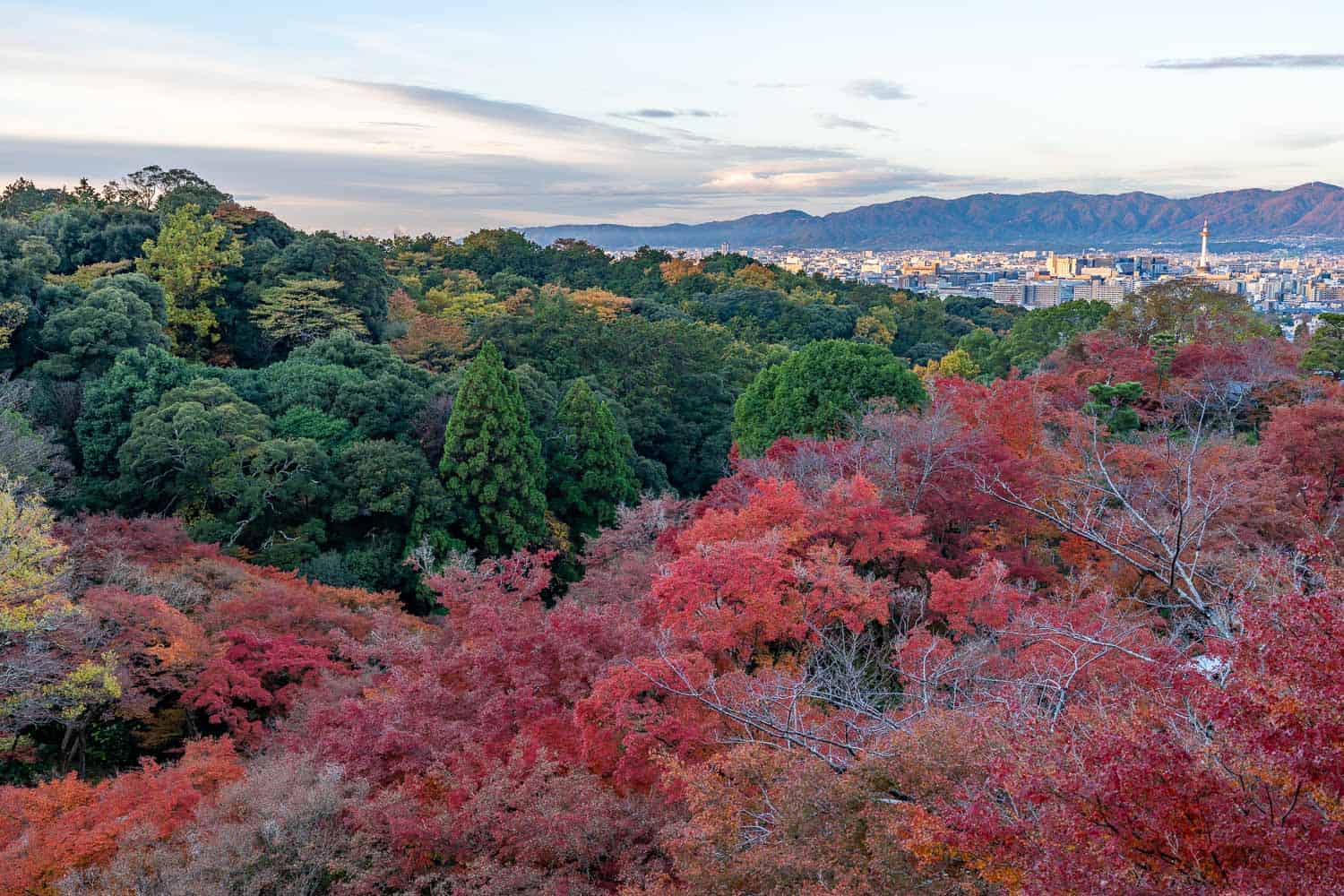
Kiyomizu-dera is one of the most famous Kyoto fall foliage spots (and one of the most visited temples at any time of year).
It gets incredibly busy in autumn, so I highly recommend doing what I did and visiting early in the morning. Unlike most temples, it opens at 6am.
On my 7am visit, it wasn’t empty, but it was much quieter and more enjoyable than our evening visit.
The night illuminations are magical, though, so do both if you stay nearby.
This is a massive complex, so allow at least an hour for your visit.
Kiyomizu-dera has many temple buildings, but in autumn, it’s famous for the mass of vibrant maples extending down the hillside—they were the most extensive of all the spots we visited.
Expect to queue to get the iconic shot of the main hall overlooking the red hillside.
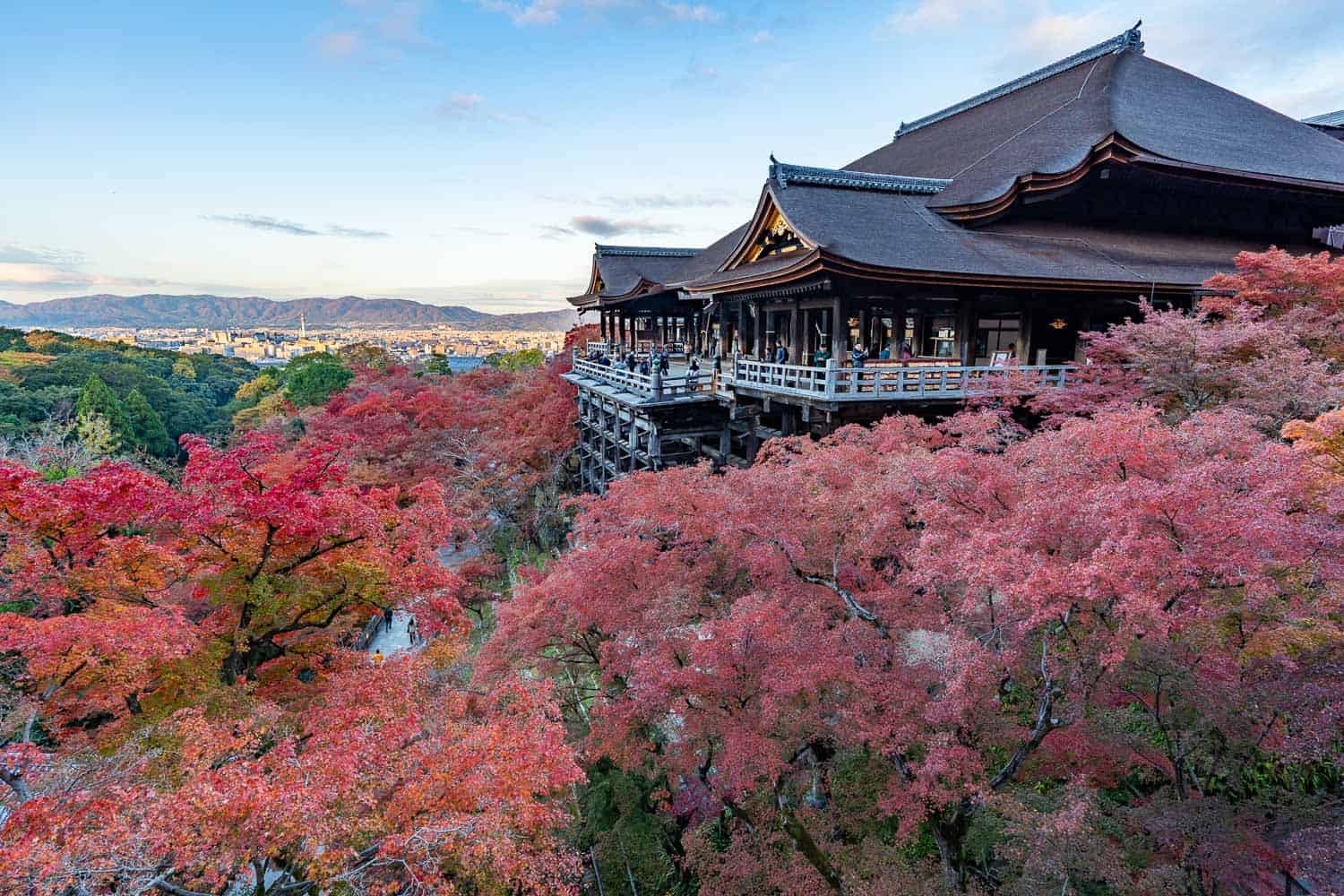
You’ll know when you get to this terrace at Okunoin Hall—hundreds of people were crammed on here at 8.30pm and I didn’t bother (you can still see the main hall from other angles). At 7am, there was still a short but manageable wait.
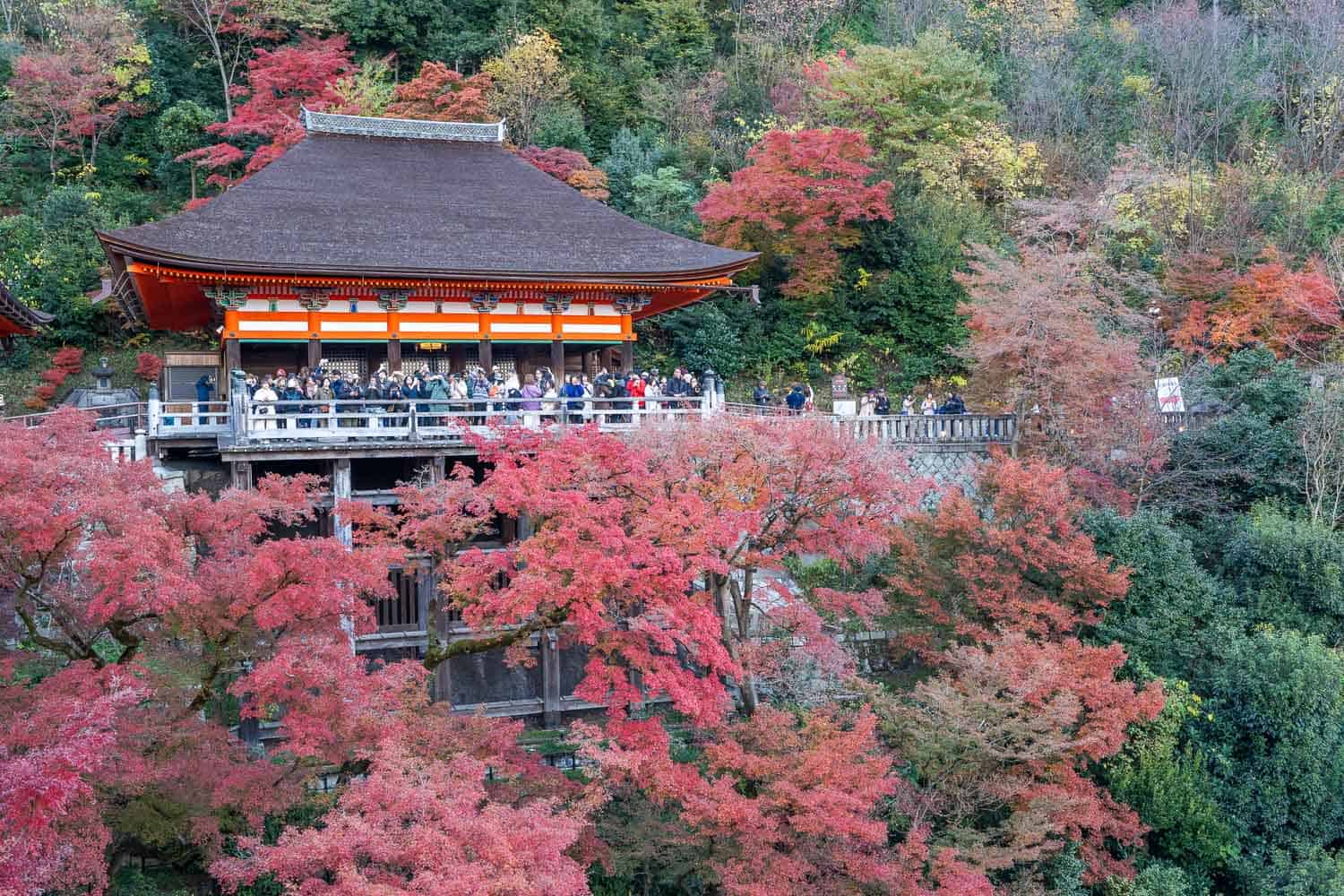
Note that if you do go early, the shops on Kiyomizuzaka (the street leading up the hill to the temple) don’t open until 10am (which can be a blessing as this street gets so crowded). Starbucks on Ninenzaka is one of the only places nearby open at 8am.
5) Arashiyama
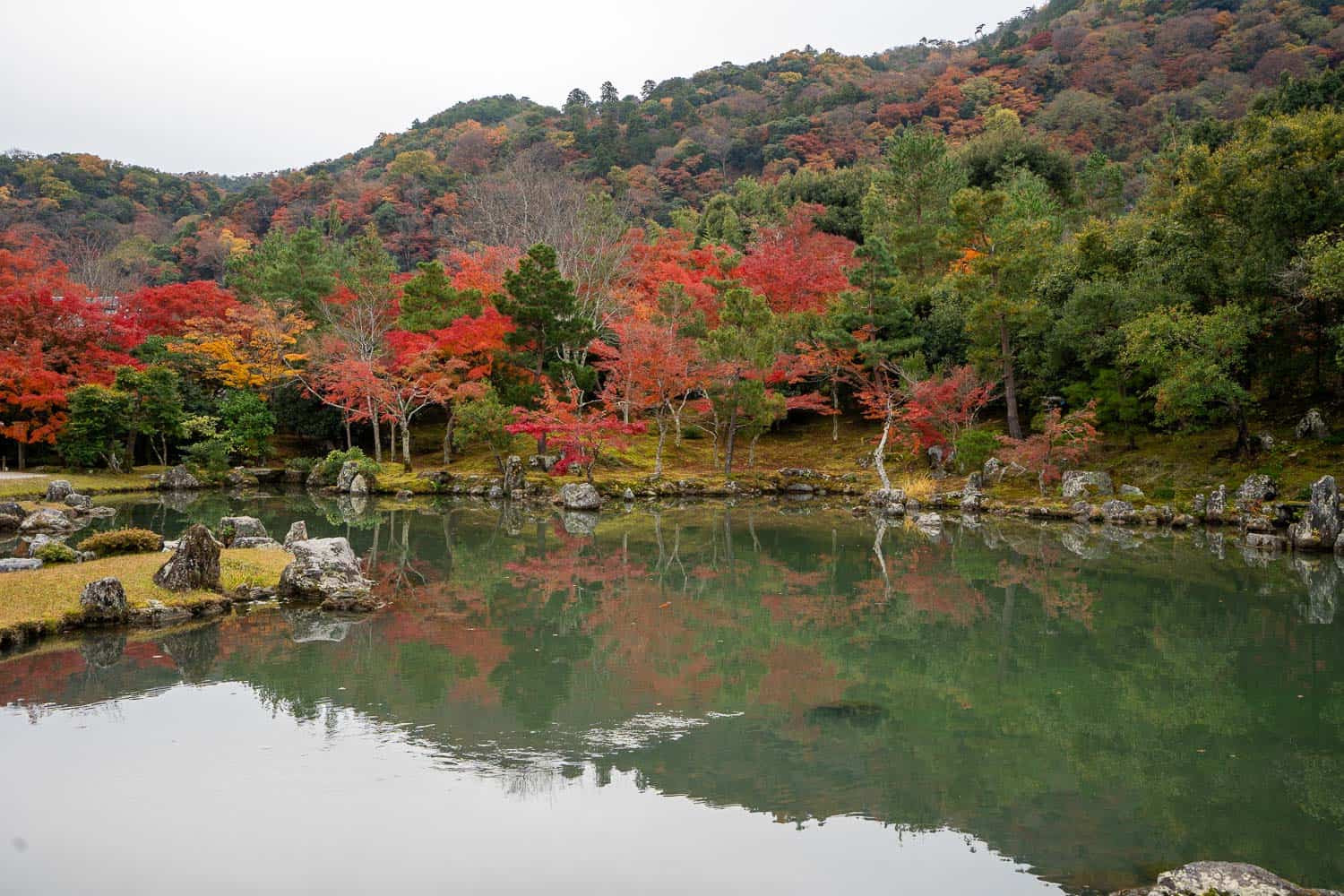
Arashiyama is a neighbourhood in the western outskirts of Kyoto that’s well worth the effort to get to, especially in autumn.
Expect very high crowds, but the payoff is the most autumnal place in Kyoto with colourful trees everywhere.
The Togetsukyo Bridge is an iconic spot to see fall colours on the hillside next to the river. You can also take popular boat trips along the river.
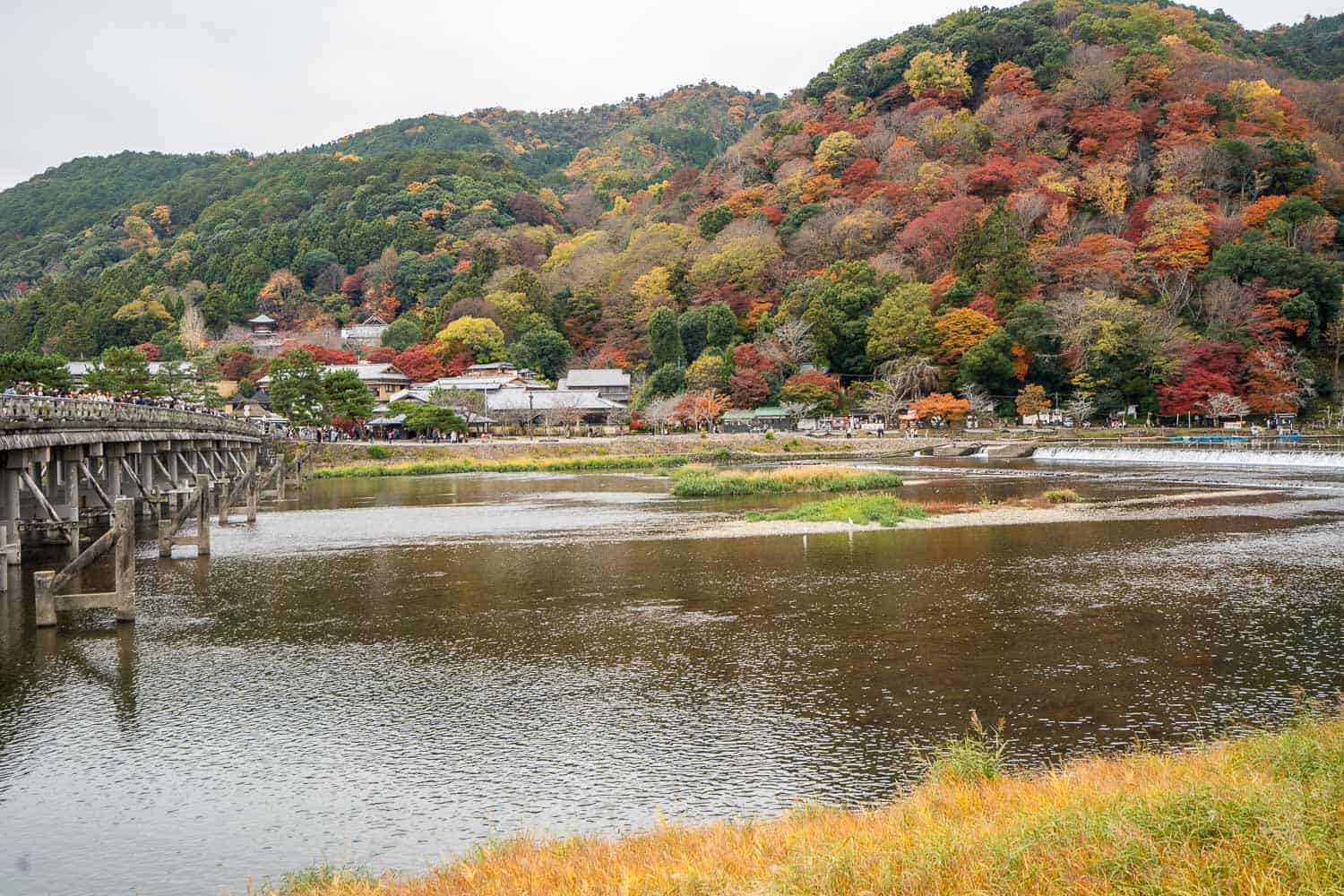
There are many temples to explore in Arashiyama, including our favourite Jojakkoji (see above).
Tenryuji is another beautiful temple, especially in autumn. The gardens are extensive with a pond and many levels to explore. Walk up the steps near the back for an even better view. You can also see some of the famous bamboo forest.
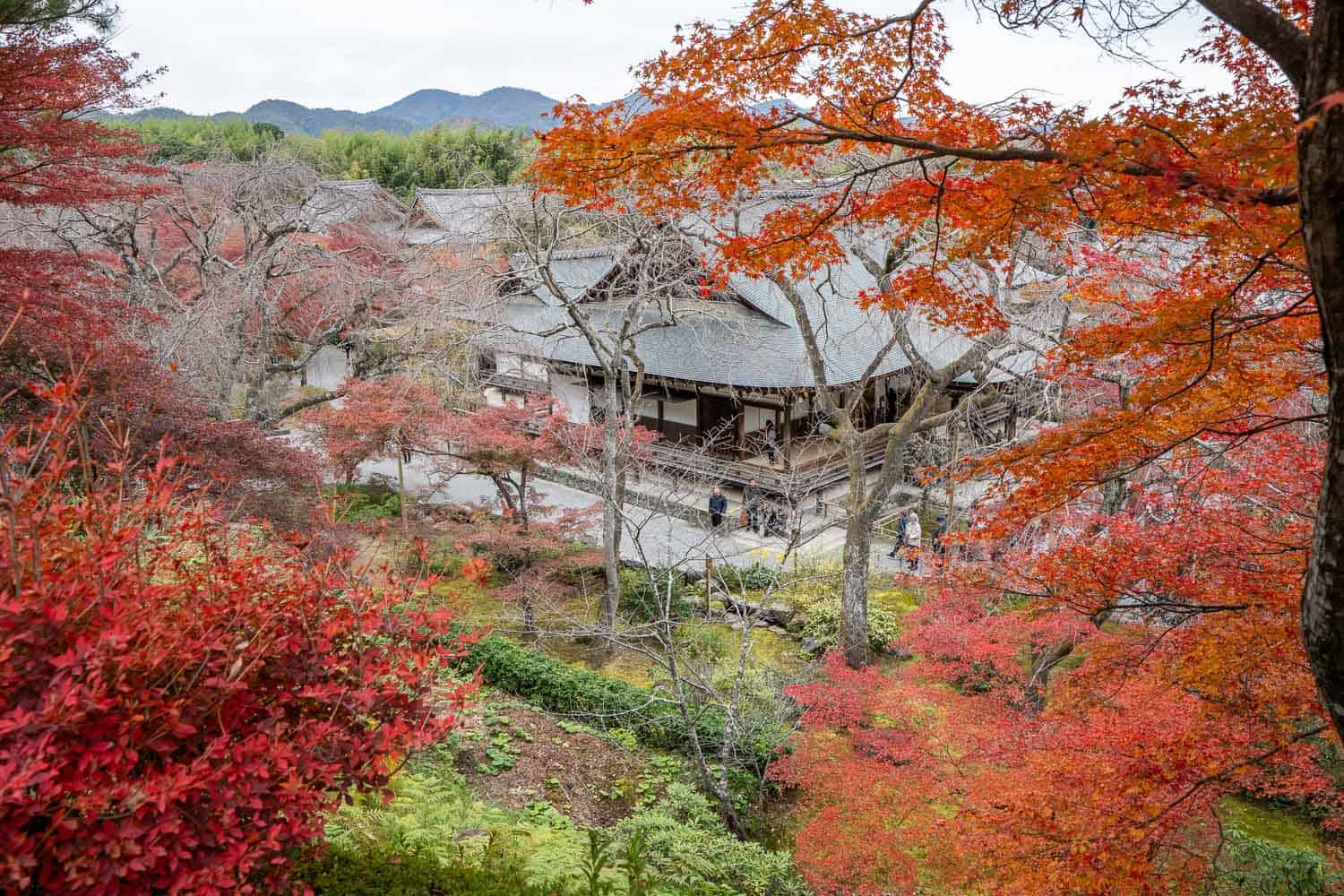
Shigetsu is a Zen Buddhist restaurant in the gardens and one of the best vegetarian restaurants in Kyoto. Be sure to book weeks ahead in autumn.
6) Saihoji Moss Temple
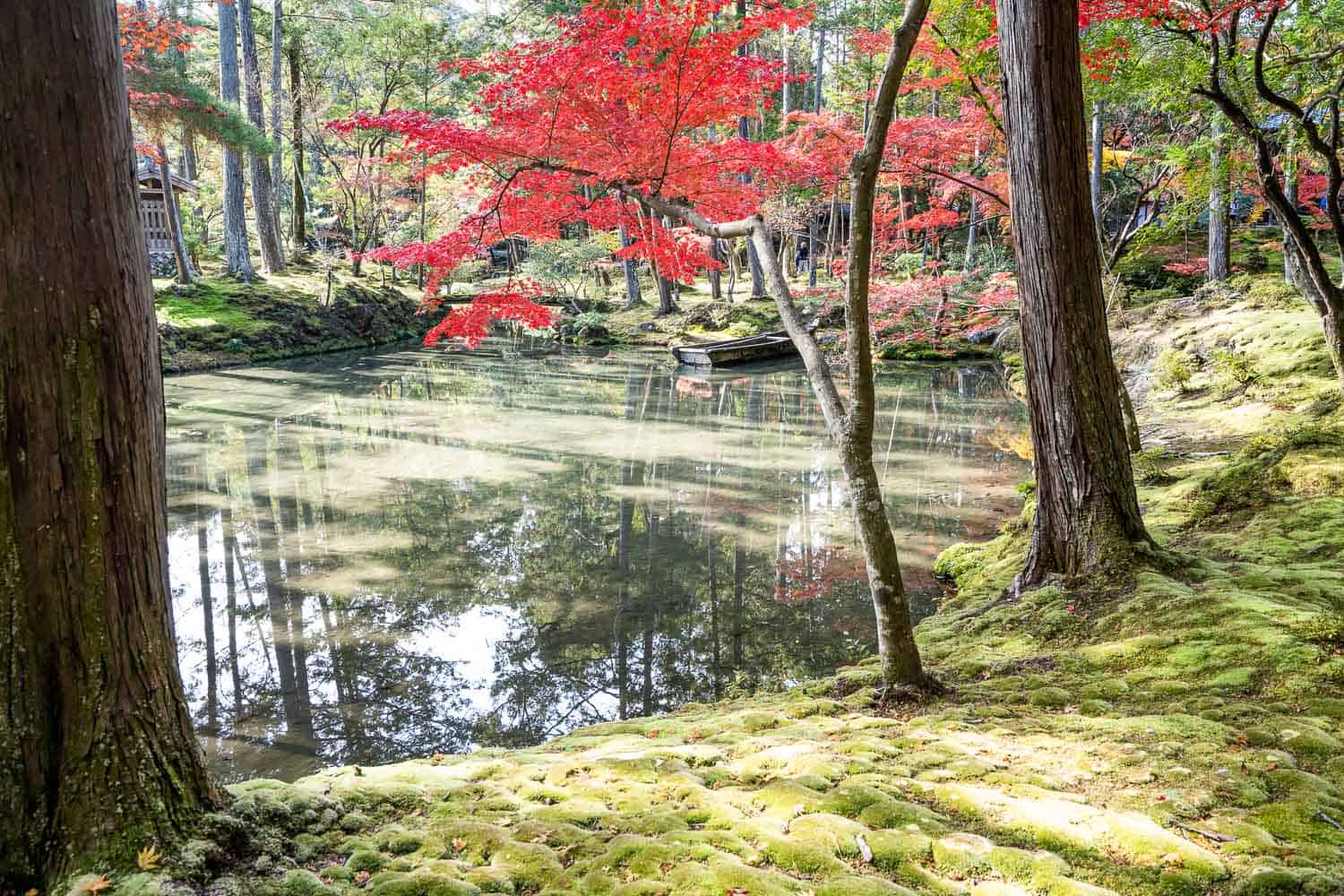
Saihoji, commonly known as the Kyoto Moss Temple, is not known as an autumn destination, but we loved it in late November.
There are enough maples to add gorgeous contrast to the vibrant green moss in the stunning gardens.
Reservations are essential to visit Saihoji, and it’s more expensive than other temples, but this makes it much more tranquil. We love it and highly recommend combining it with Arashiyama.
See my guide to the Kyoto Moss Temple for everything you need to know.
7) Kibune and Kurama
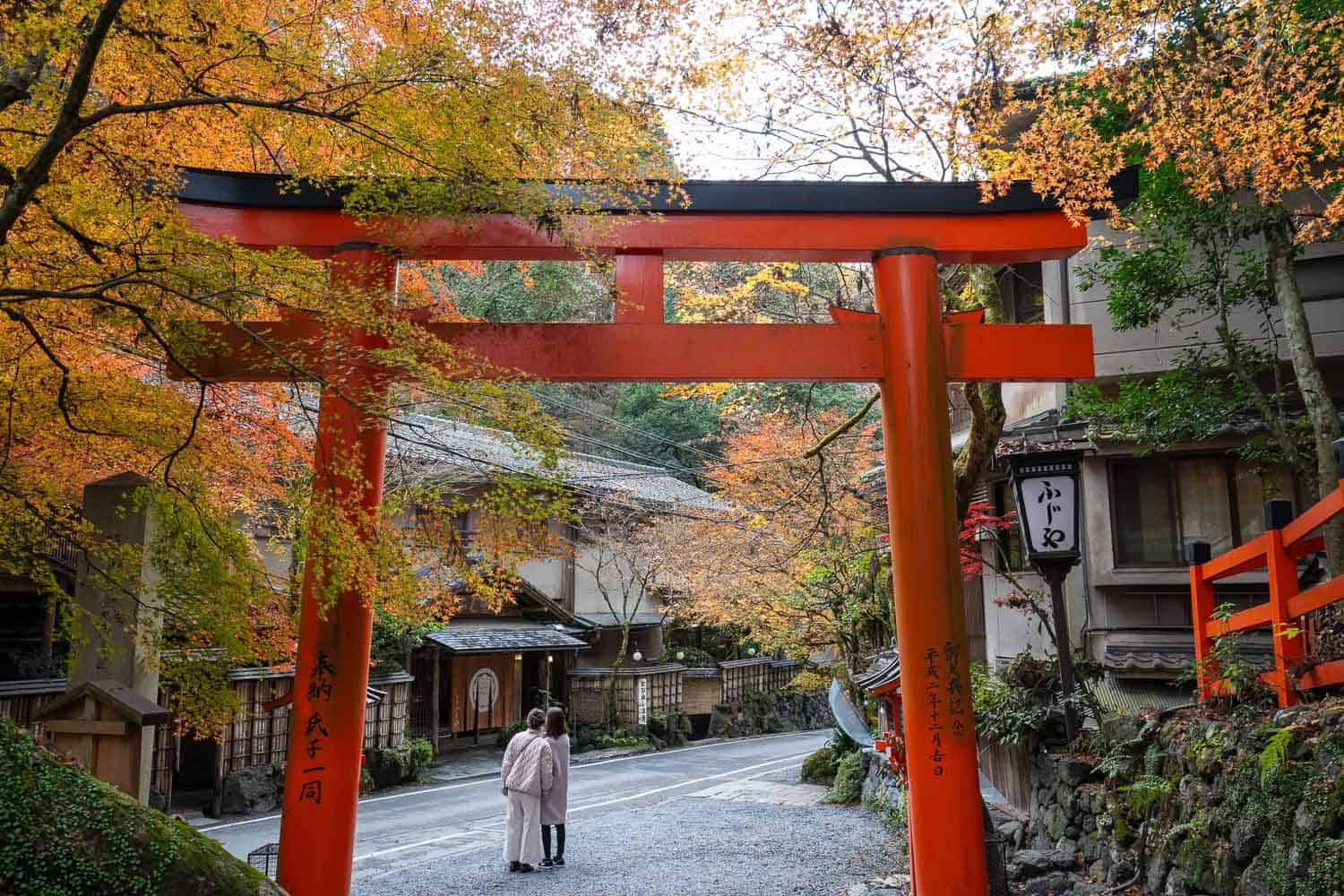
Kibune and Kurama are two small villages in Northern Kyoto. Combined with a hike through the forest over the mountain between the two, this is one of my favourite day trips from Kyoto and a (relatively) peaceful escape from the city.
Autumn is a beautiful time to visit. The leaves turn earlier at these higher elevations, and they were past peak when we visited on 26 November.
We took the Eizan train to Kibune, which takes you through a pretty tunnel of maple trees. From the station, we walked up the road to Kibune Shrine, then through the west gate to Kurama-dera (500 yen/ $3.50 entrance).
A trail through the forest (with a steep climb at the beginning) brought us to Kurama-dera where the colours were more vibrant than in Kibune and the mountain views are fantastic. As we got there by 10am, it wasn’t too busy.
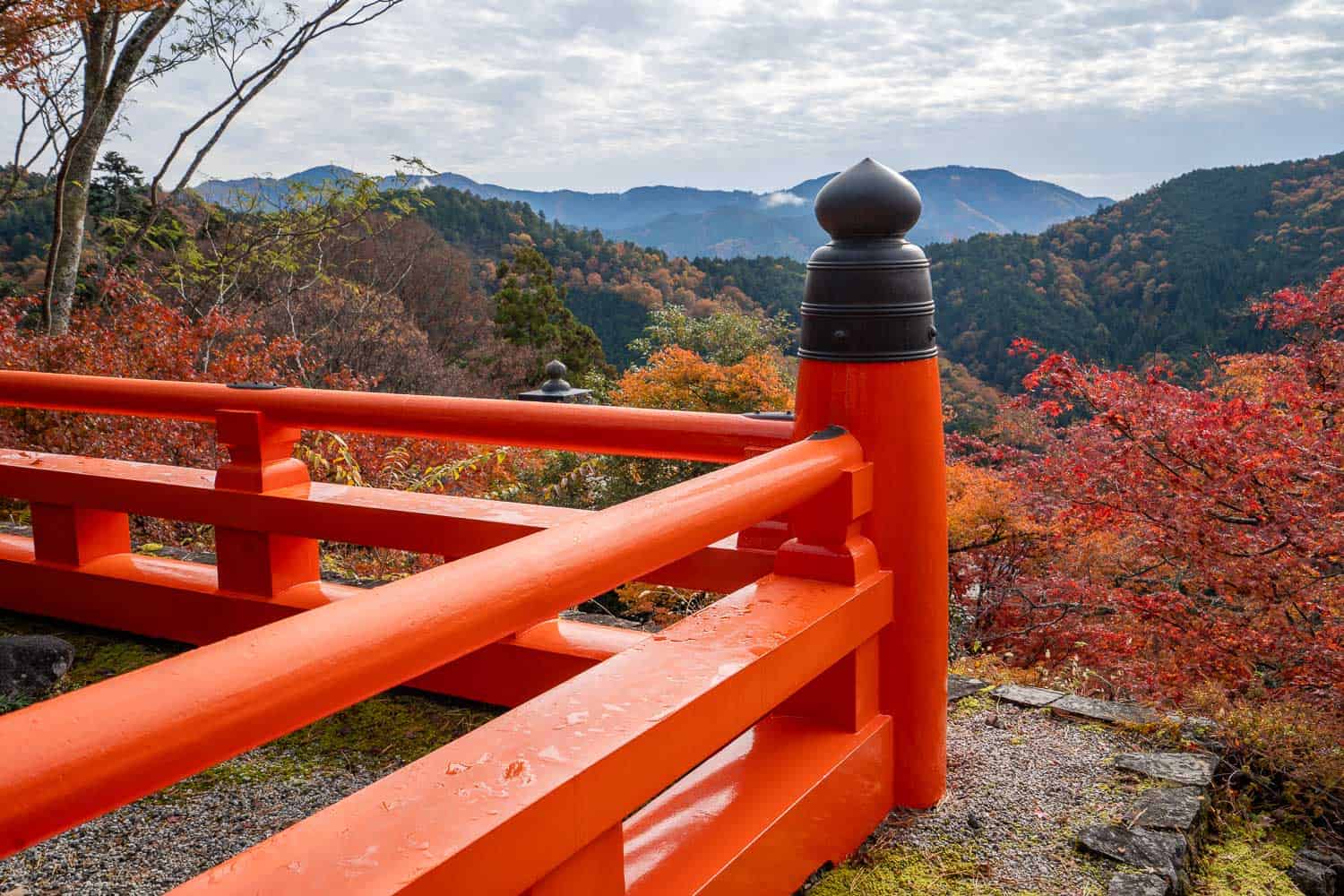
We then walked down to Kurama village, where we had an excellent vegetarian lunch at Yoshuji (see our vegetarian Kyoto guide) before taking the train back to Kyoto from Kurama station.
Our 5km (3 mile) walk took about two hours (including time to explore Kurama-dera) with 321 metres (1053 feet) of elevation gain. It wasn’t too challenging but wear decent shoes.
This is an excellent and easy half-day trip if you want some exercise, a taste of the Japanese countryside, fresh mountain air, and some pretty fall colour (especially earlier in the season).
If you don’t want to hike, you could take the train to Kurama and then the cable car up to the temple.
8) Tofukuji
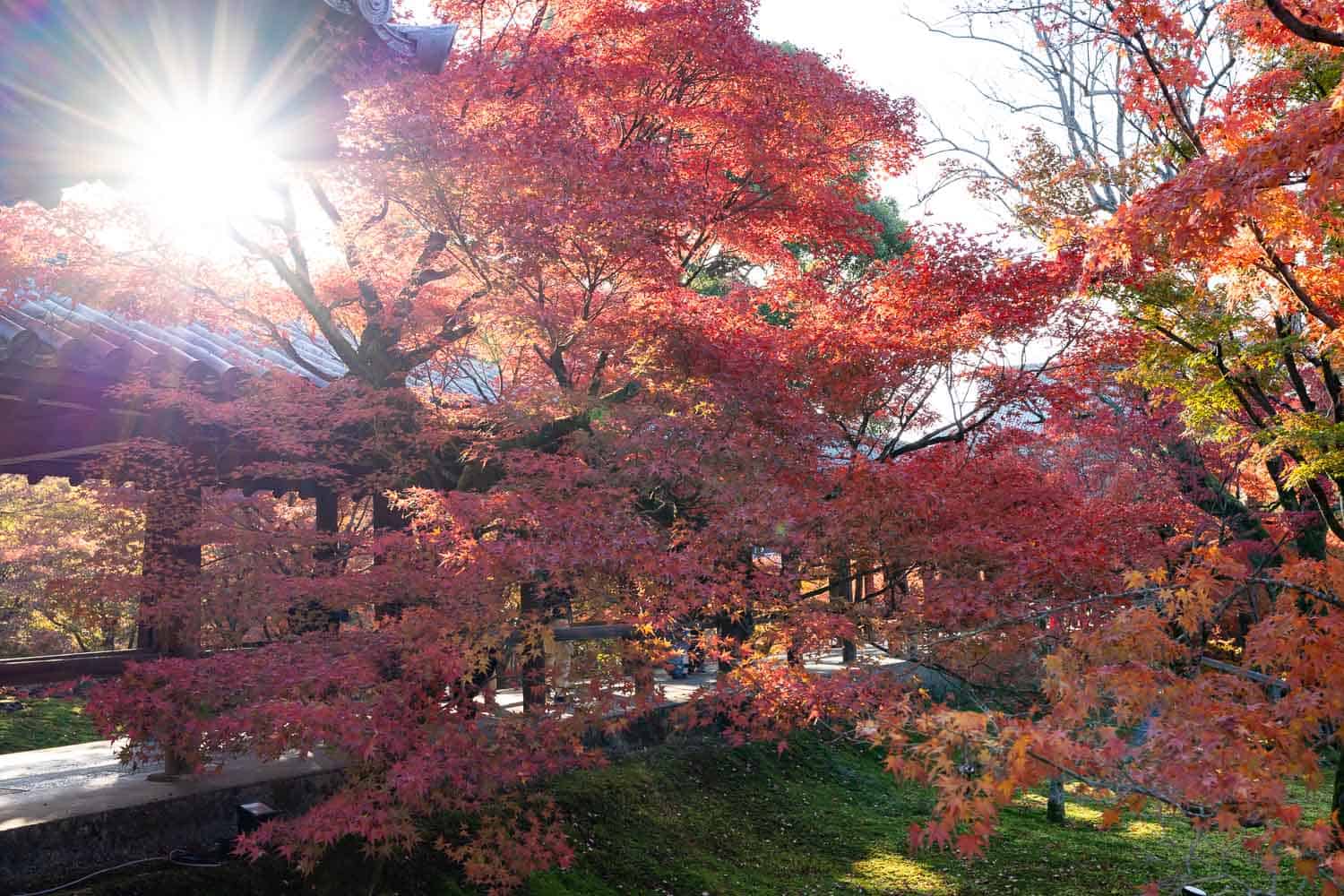
Tofukuji is a Zen temple that goes under the radar most of the year, but visitors descend in autumn as it’s one of the most famous fall colour destinations.
The colours are vibrant and extensive, but we didn’t enjoy it as much as those above as the crowds were so intense, even arriving at 8.30am opening. It costs 1000 yen ($7) in autumn.
The most popular view is of and from the Tsutenkyo Bridge, a covered wooden walkway through a valley of maple trees.
9) Nanzenji
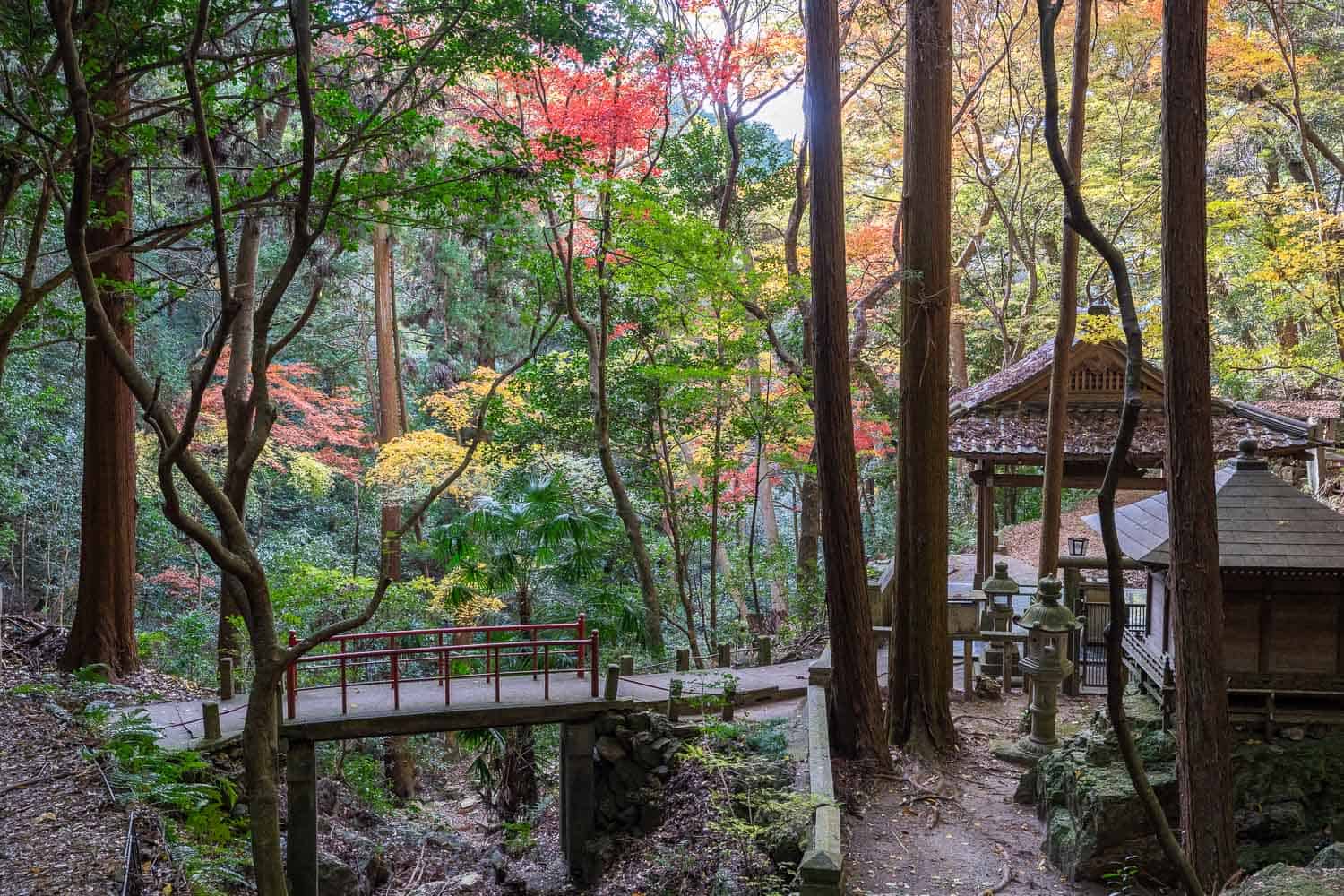
Nanzenji is a fantastic temple complex to visit anytime, but autumn is especially beautiful.
Located near the start of the Philosopher’s Path, it’s easy to combine with other temples in the area (and we usually walk from Gion with stops on the way).
Much of the complex is free, and you can see autumn colour throughout, including the huge Sanmon entrance gate, the brick aqueduct, and the serene little Saisho-in sub-temple.
We always love walking up the forested hillside to the Okunoin shrine. It’s never busy up there and there were splashes of colour amongst the green forest. You feel so far from the city.
One subtemple worth paying for is Tenjuan (to the right when you enter Nanzenji), which is quieter than the main areas.
After passing the Zen rock garden, stroll through a mossy gate to a pond, which feels magical with its stepping stones, mossy banks, little waterfall, lily pads, and fallen maple leaves.
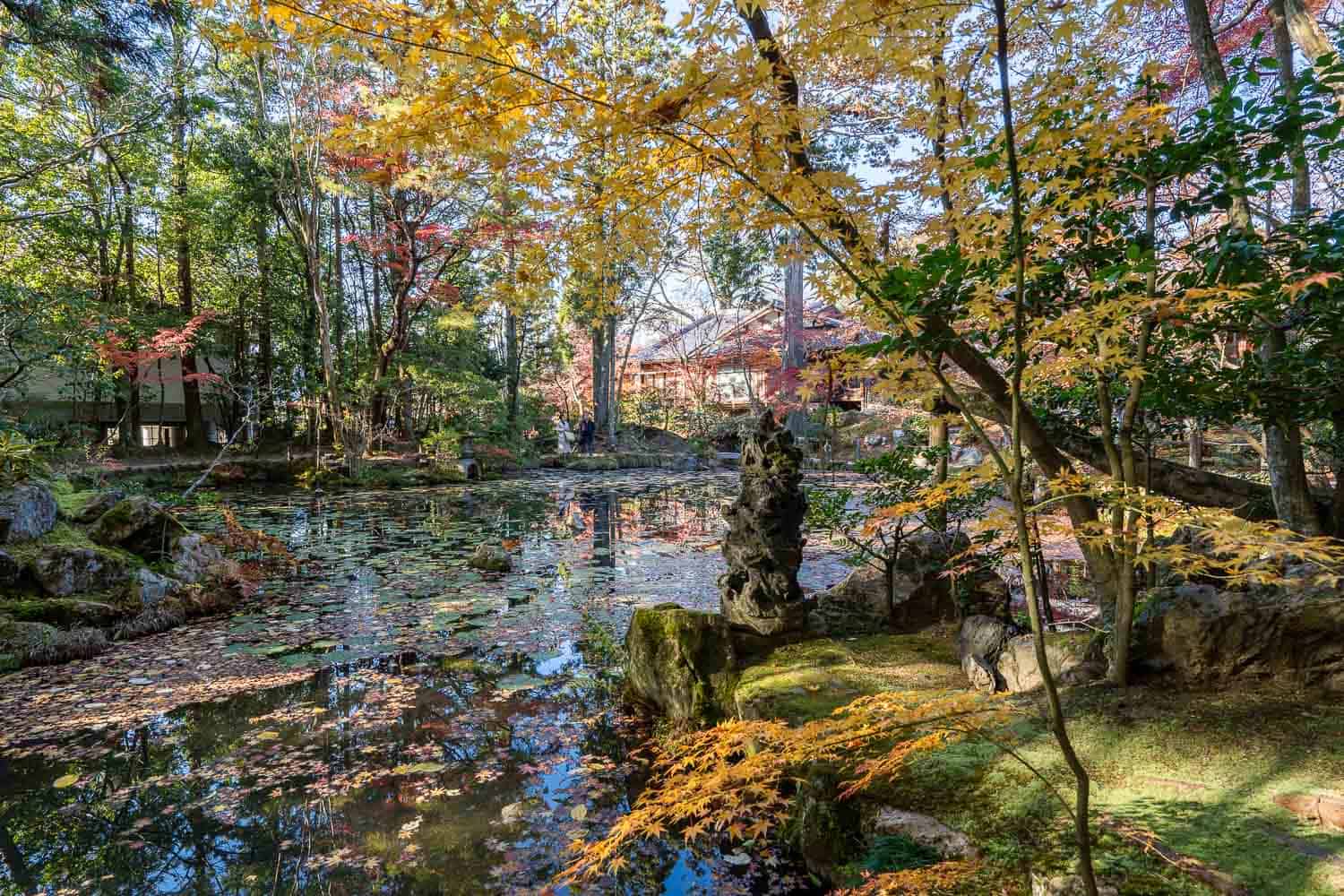
On 4 December, it was past peak, but it must have been stunning a week earlier.
10) Murin-an Garden
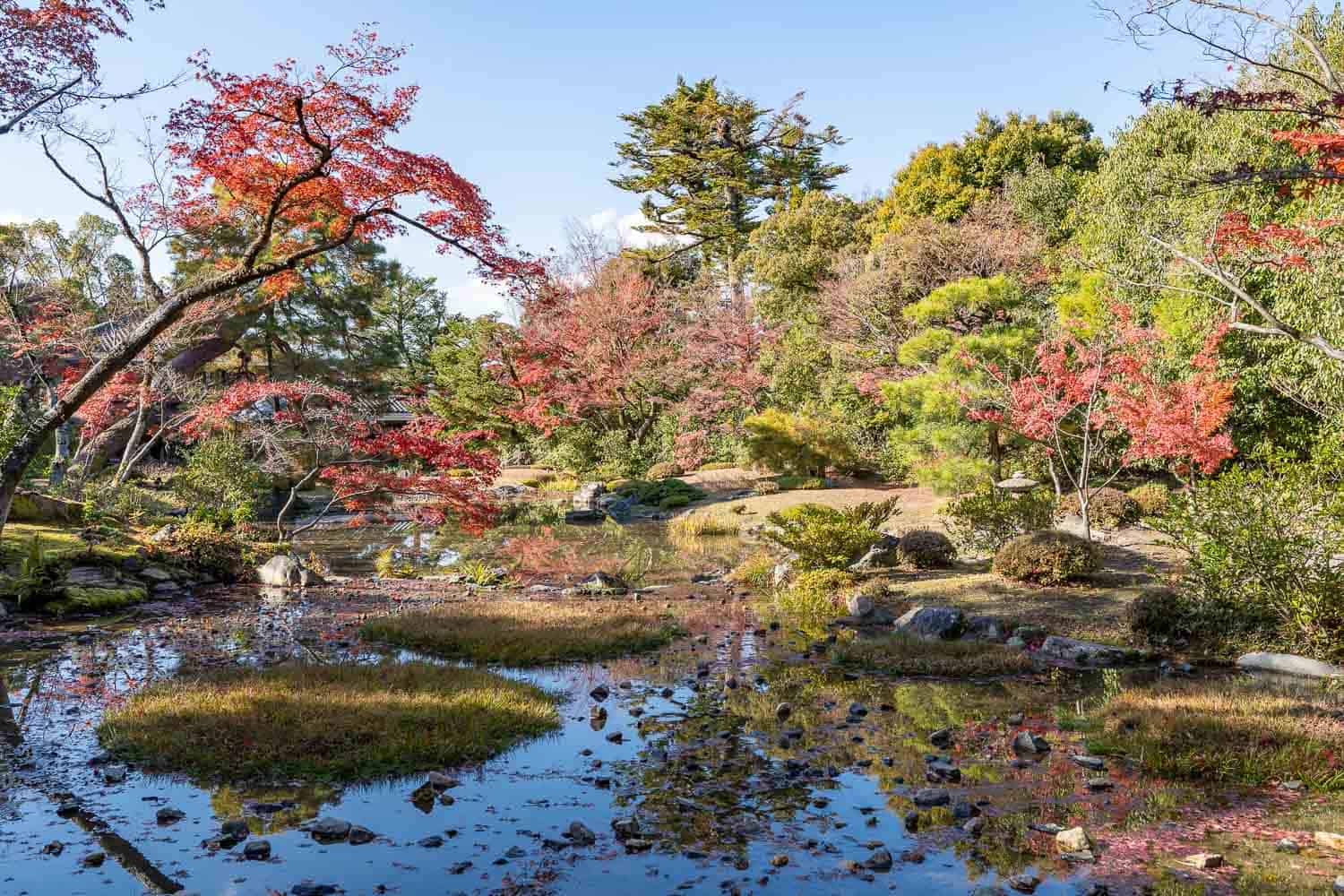
Murin-an isn’t an iconic fall colour spot, but it’s a good quieter option, especially for garden fans.
This modern Japanese garden (dating back to 1896) is on the grounds of a late 19th-century villa. It’s a 10-minute walk from Nanzenji.
You must book in advance on the Murin-an website; the price depends on the date. Booking a day or two ahead should be fine. In early December, I went on the cheapest 600 yen ($4) date, which was very peaceful.
I paid an extra 1200 yen ($8.50) for matcha and sweets to start my visit sitting on tatami in the tearoom overlooking the garden.
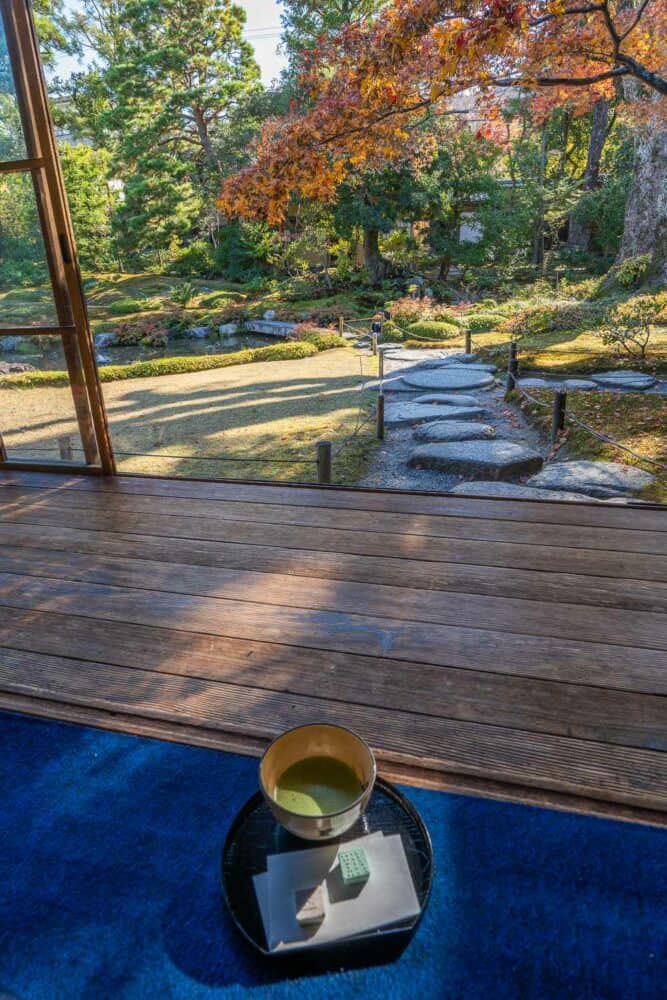
While it wasn’t my favourite matcha (and it’s pricey), it was a relaxing place to linger and enjoy the view of the yellowing maple.
The garden only takes about 10 minutes to wander around, but it’s lovely with stepping stone pathways, a stream, little waterfall, some scarlet maples, and the Higashiyama Mountains in the distance.
Autumn Temple Illuminations
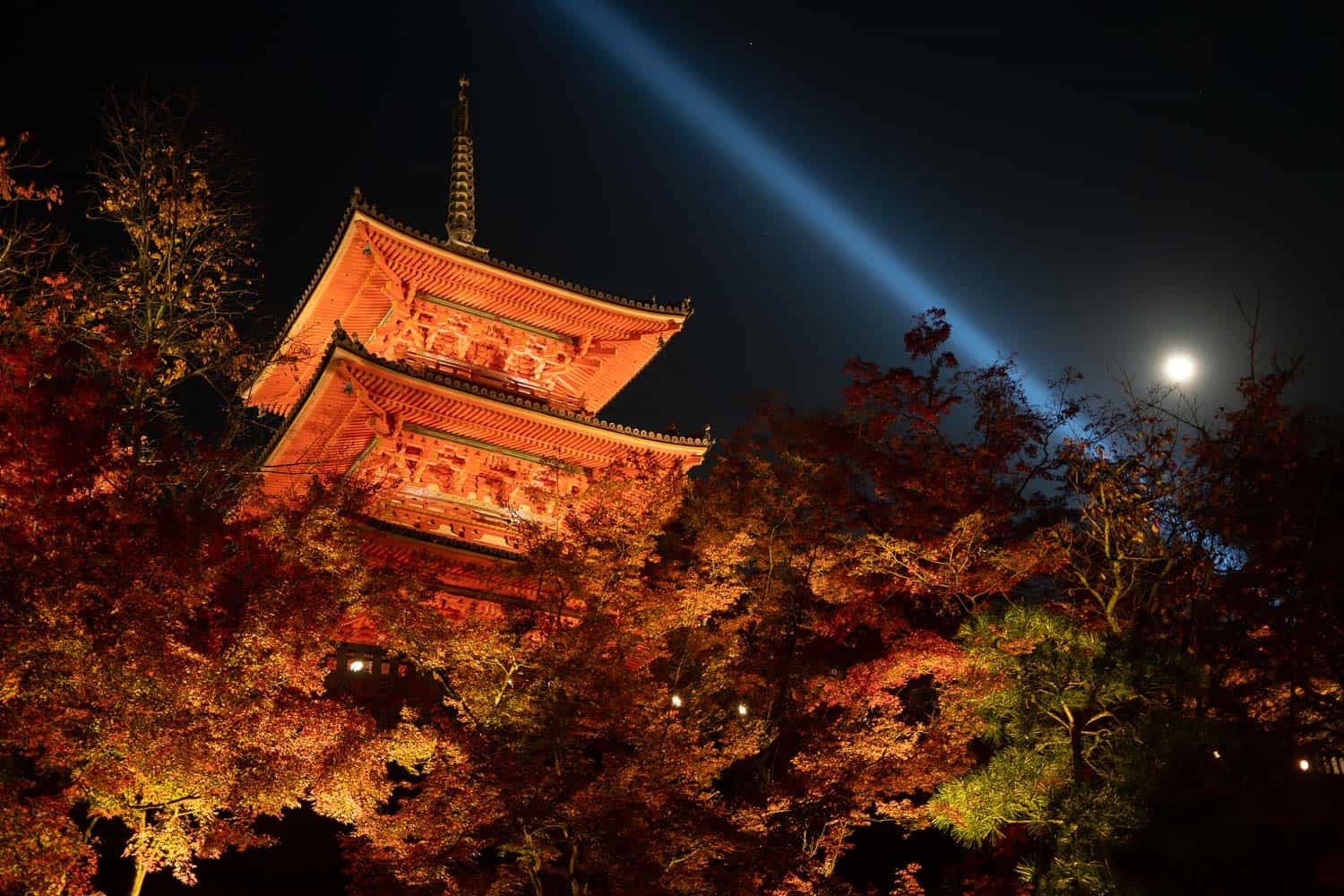
In spring and autumn, some Kyoto temples open for evening illuminations, and it’s worth visiting one or two for a different perspective on the gardens.
Illuminations usually start in mid-November and run until early December, but check the dates for each temple as they change slightly each year.
Expect crowds at these events. They usually run from around 5.30pm to 9pm and will be quietest in the last hour (although we still found them very busy). Try to visit on weekdays.
These are some of the most popular temple illuminations in autumn:
- Kiyomizu-dera
- Eikando
- Tofukuji
- Kodaiji
- Toji
See the Souda Kyoto website for a full list (translate from Japanese).
Where to Stay in Kyoto in Autumn
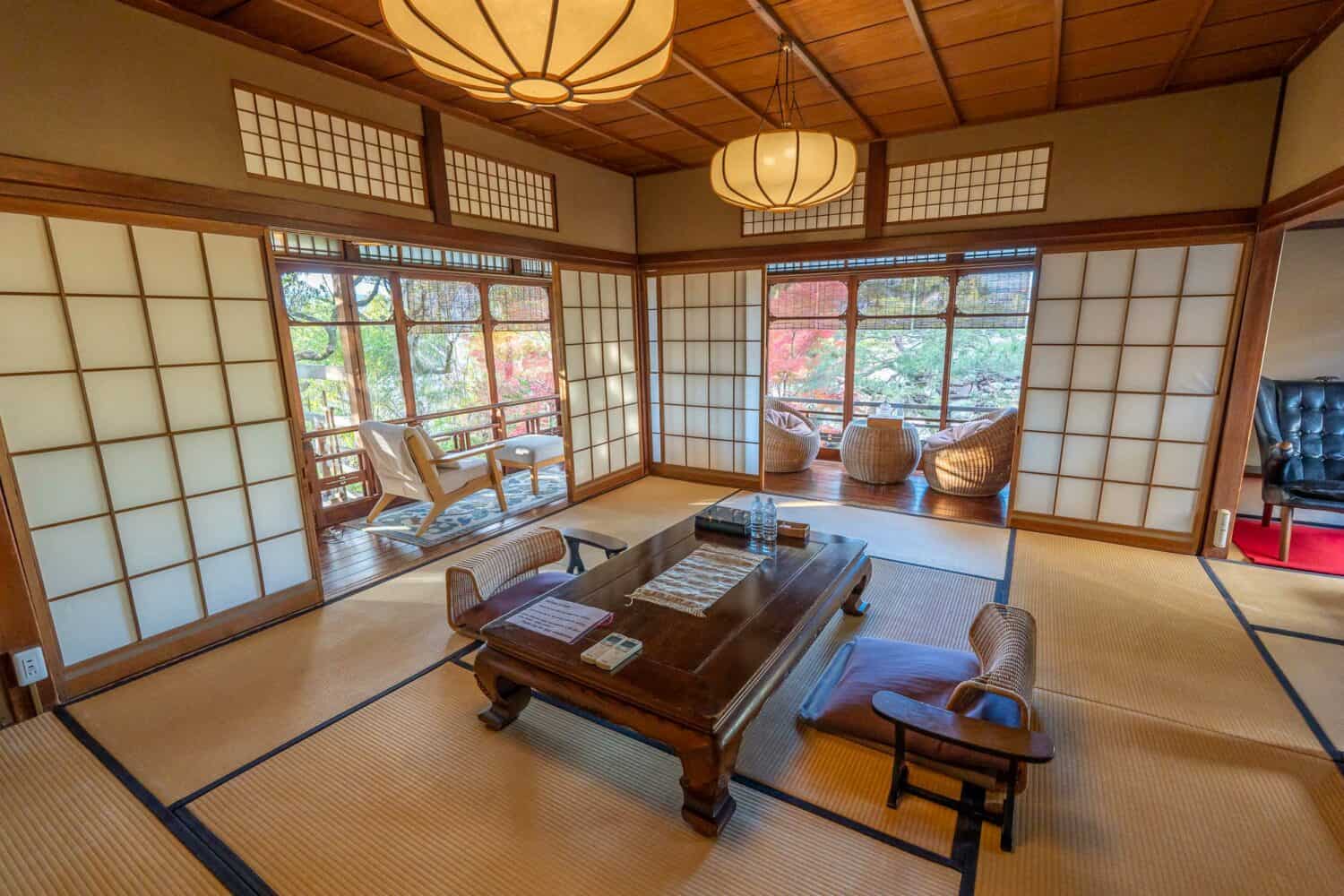
As autumn in Kyoto is peak season, it does help to stay close to the main sights for early starts. Make sure to book well ahead (ideally 3-5 months before).
Hotel The Celestine in Gion is a 15-minute walk from Kiyomizu-dera, perfect for that essential early morning visit.
Yachiyo Ryokan is only five minutes from Nanzenji and 10 minutes from Eikando, which was especially convenient for the night illumination. Our huge room had a private onsen and a view of a scarlet maple tree in the garden.
See our guide to where to stay in Kyoto for full reviews of both these, plus other recommendations of places we’ve stayed.
Weather in Kyoto in Autumn
While early November in Kyoto can still be hot (it was 26ºC/ 79ºF on our visit), the temperature drops rapidly through the month.
By 10 November, temperatures were down to around 15ºC, and in the middle of the month, it felt like winter arrived overnight with 7ºC temperatures in the morning.
By the end of November (peak fall viewing time), temperatures ranged from 3ºC in the morning to around 12ºC during the day.
It didn’t rain much, but it was often cloudy.
Layers are the best way to dress for Kyoto in autumn.
I usually wore a long-sleeved t-shirt, light cashmere sweater, lightweight Patagonia down jacket, jeans, woolly hat and gloves. My Allbirds Wool Runners served me well as they are warm, comfortable, and easy to slip off at temples.
We picked up extra winter clothes from Uniqlo, which has reasonable prices and the Heattech range is great for layering. You can also buy hats and gloves from convenience stores.
Map of Kyoto Autumn Foliage Spots
Is Kyoto in Autumn Worth It?
Autumn is one of the busiest and most expensive times of year to visit Kyoto, but for us, it was worth it. There are so many temples and gardens where you can enjoy truly stunning fall colours.
Kyoto is beautiful at any time of year, but autumn (and spring) are extra special.
More Japan Posts
Kyoto
- 26 Unforgettable Things to Do in Kyoto, Japan
- 14 Best Day Trips from Kyoto
- 14 Stunning Places to See the Cherry Blossoms in Kyoto
- The Ultimate Guide to Kyoto Temples and Shrines
- Where to Stay in Kyoto: Recommended Hotels and Areas
General Japan Tips
- Planning a Trip to Japan: Dos and Don’ts
- 16 Unmissable Places to Visit in Japan
- Two Weeks in Japan: A Detailed Itinerary
- 56 Best Things to Do in Japan for an Unforgettable Trip
- Where to Stay in Japan: The Ultimate Guide to Accommodation
If you enjoyed this post, pin it!
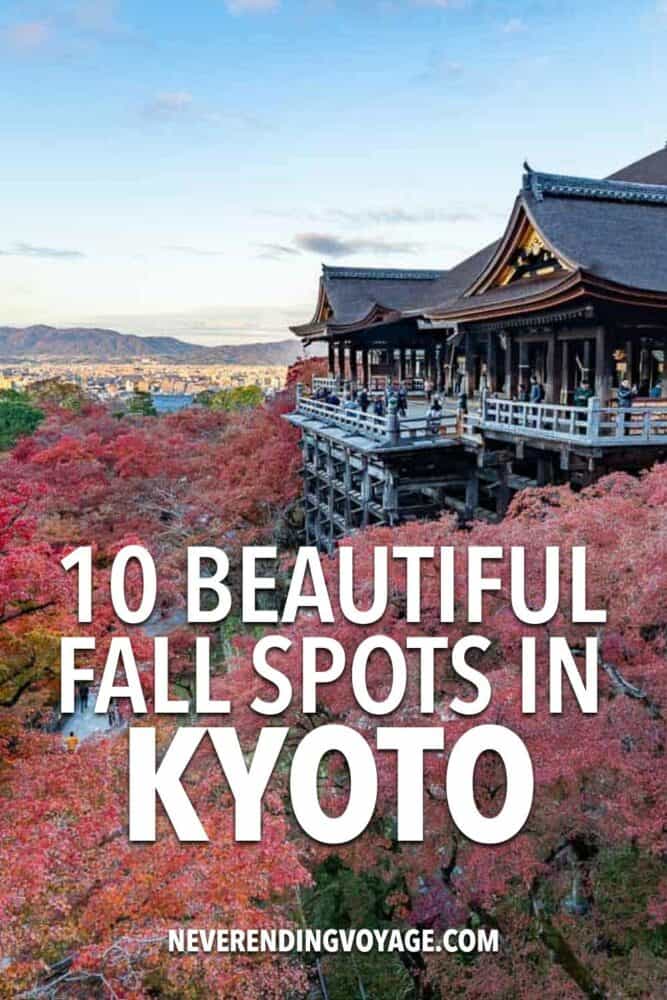
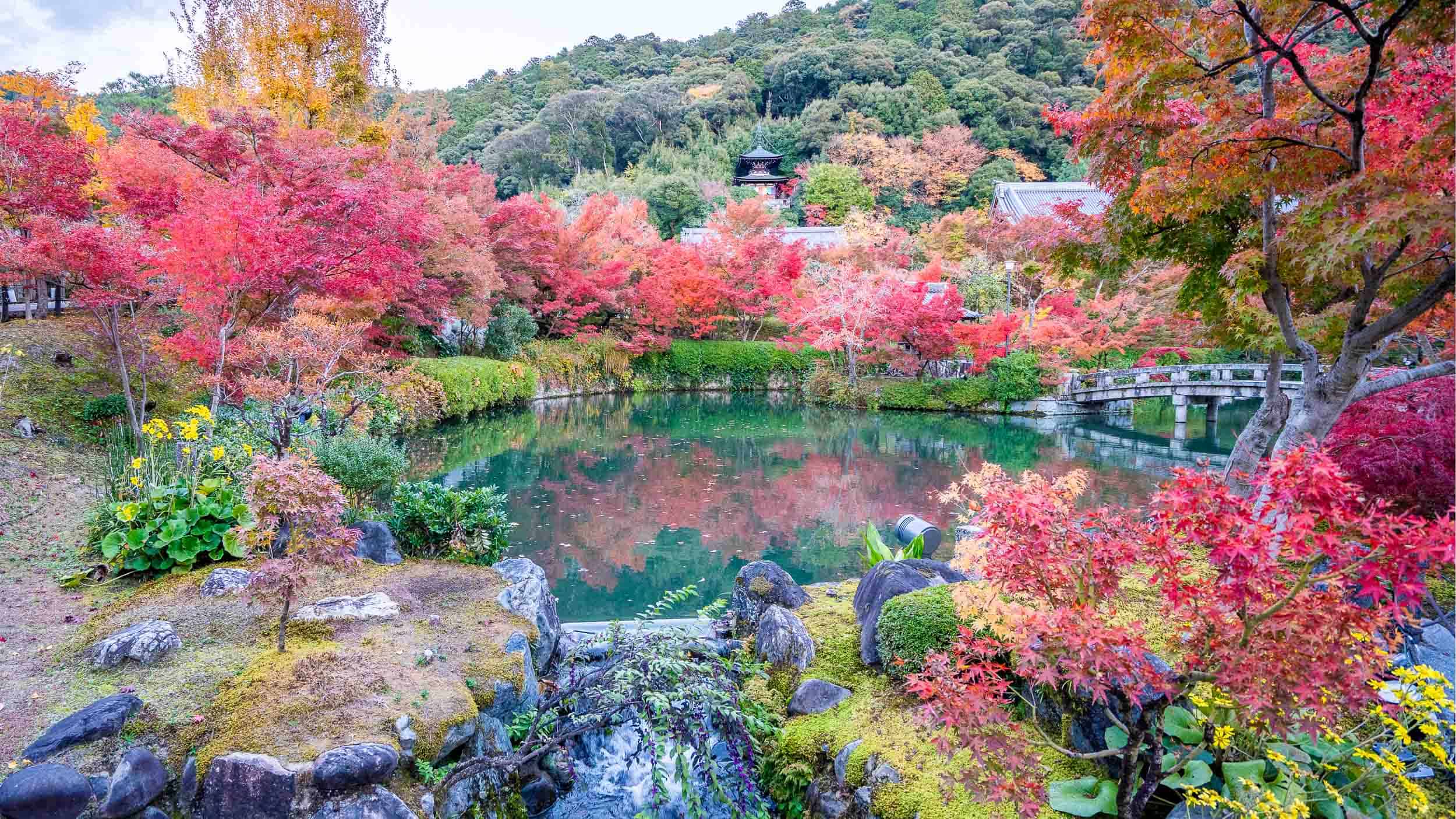
Super thank you! Among all the blogs i have read so far, this what i liked most, as it is very informative and is honest in stating which are very crowded.
Very helpful to assess which ones we will go to.
The websites mentioned are also very useful in tracking the foliage.
Hoping to spot beautiful maple leaves in our trip this November!
Thanks for the kind words, Thomas! I am sure you will see some beautiful foliage in November – enjoy!